
Beginner Bodyweight Workout Plan for Building Muscle—Full Guide
Bodyweight workout plans can be incredibly good for building muscle, especially in your upper body. If you put enough mechanical tension on your muscles, they’ll grow. That’s just as true with bodyweight exercises as it is with free weights or exercise machines.
However, most bodyweight workout plans are designed to help people get fitter, not more muscular. If you’re trying to build muscle, that won’t cut it. To maximize your rate of muscle growth, you need to train for muscle growth. You need to do bodyweight hypertrophy training.
In this article, we’ll teach you the best bodyweight exercises for building muscle, then give you a full hypertrophy training workout routine you can do at home.
- Can Bodyweight Exercises Build Muscle?
- The Principles of Muscle Growth
- Bodyweight Progressive Overload
- The 4 Best Bodyweight Exercises for Building Muscle
- One: Push-Ups
- Two: Chin-Ups (or Inverted Rows)
- Three: Bodyweight Squats
- Four: Bodyweight Deadlifts
- Bodyweight Isolation Exercises
- The Bodyweight Workout Routine
- Should You Ever Get Free Weights?
- Conclusion
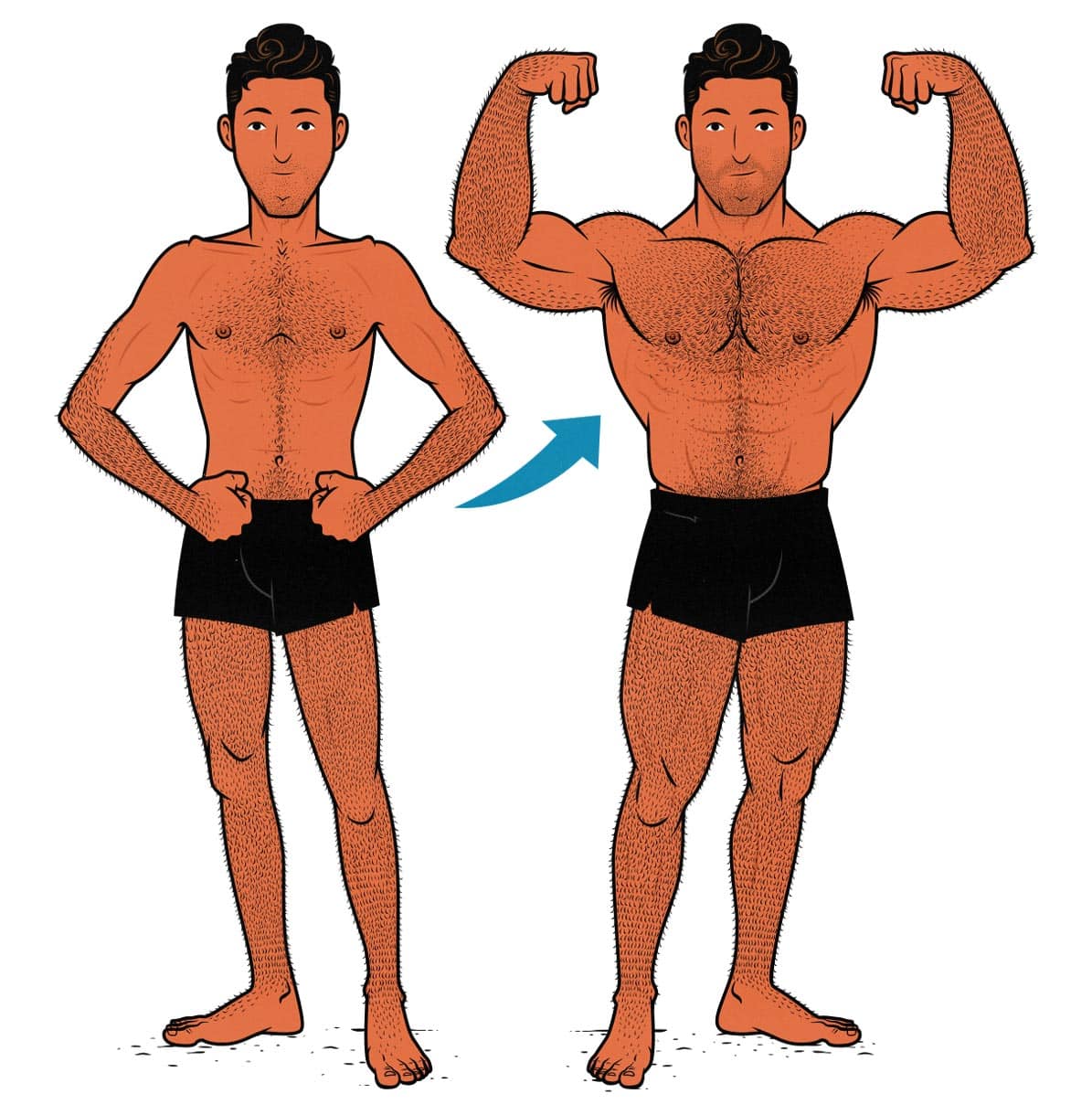
Can Bodyweight Exercises Build Muscle?
You can build muscle with bodyweight exercises just as quickly as if you were using weights. Push-ups and chin-ups are two of the best muscle-building lifts of all time. If anything, they’re better than bench presses and rows (study, study).
Bodyweight exercises can be good for gaining strength, too. Not in the powerlifting sense, where strength is measured by your 1-rep squat, bench press, and deadlift, but in the sense where you’ll build a strong and functional body.
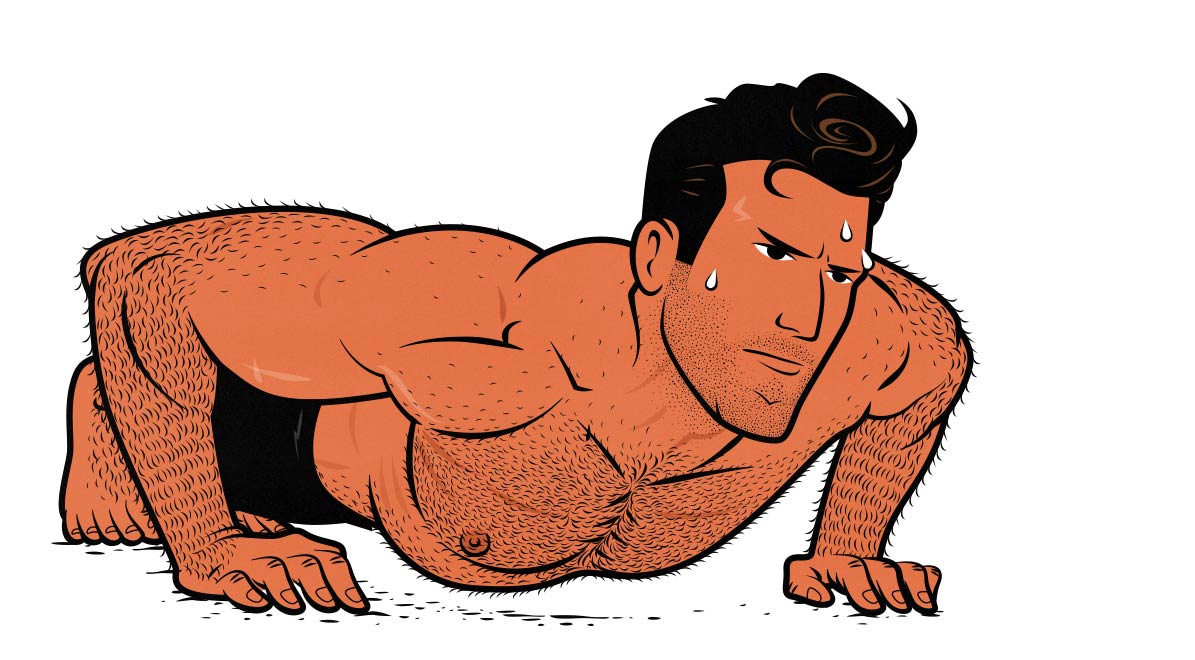
The downside is that bodyweight training can be more complicated and painful than lifting weights. When you’ve got a barbell, progressive overload is as simple as adding a few extra pounds to the bar. With bodyweight training, you need to add reps (which hurts) or switch to more difficult exercise variations (which, if you aren’t careful, can change the muscles you’re training).
If you’re willing to grit your teeth and put in the reps, you can do this. You can build a tremendous amount of muscle with bodyweight training. You just have to be a scrapper.
Now is no time to think of what you do not have. Think of what you can do with what there is.
The Old Man and the Sea
The Principles of Muscle Growth
The simplest way to explain muscle growth is with the story of Milo of Croton. Milo was the prototypical skinny guy who dreamt of being muscular, so he had the idea to challenge his muscles by carrying around a calf. He was skinny (and calves can weigh as much as 500 pounds), so that was more than enough to challenge him, provoking muscle growth.
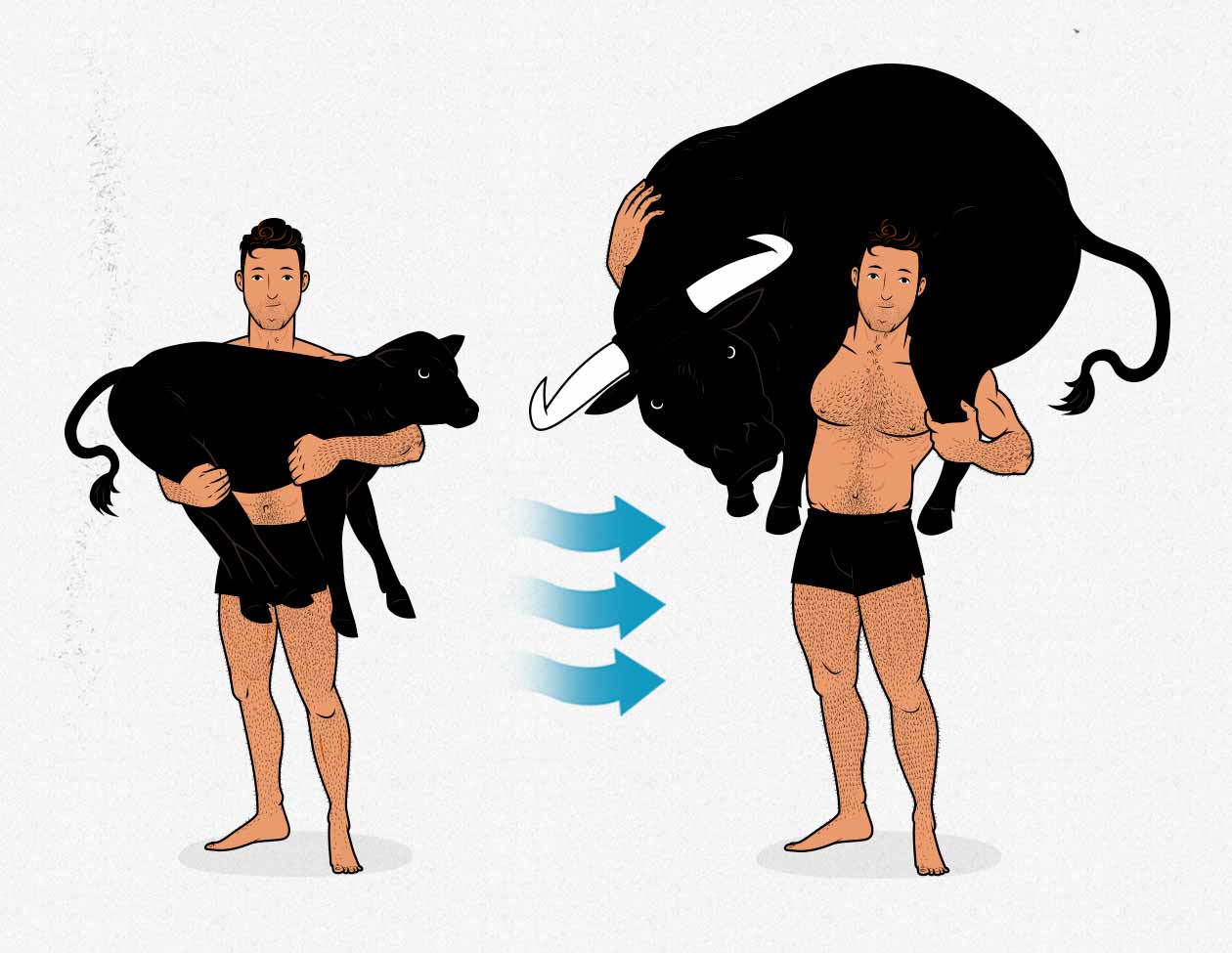
After carrying the calf, he feasted, slept, and grew bigger. Then he went back to carry the calf again. Of course, as Milo grew bigger, so too did the calf, and so his bigger muscles were always challenged by the ever-heavier calf.
Now, I realize you’re probably more interested in bulking up your chest and arms than your calves, but the same principle holds true. We need to challenge our muscles enough to stimulate growth, recover by eating enough calories and getting good sleep, and then challenge our muscles again—doing more than last time. This idea of always doing more is called progressive overload, and it’s at the heart of both strength and hypertrophy training (aka training for muscle size).
- Lift.
- Eat.
- Rest.
- Lift more than last time.
It’s easy to get caught up in the magic of the hypertrophy rep range, the advantages of certain lifts, or the benefits of certain techniques, but the most important thing is to simply challenge our muscles by bringing our sets close enough to failure (or even all the way to failure). If we’re always lifting close to failure and always striving to do more, then our muscles will be forced to grow bigger.
And then, of course, once we’ve stimulated muscle growth, we need to kick back, eat big, and get a good night’s sleep. That’s what allows us to build muscle. That’s how we can show up to our next workout bigger and stronger than last time.
Bodyweight Progressive Overload
The supposed problem with callisthenics is that we can’t progressively increase the amount of weight we’re lifting. That’s not quite right. We’ll be gaining weight, adding more weight to our bodyweight exercises. When I started doing chin-ups, I weighed 130 pounds. Now I weigh 200 pounds. The chin-ups gradually got much heavier.

Even so, adding a pound of muscle to our frames allows us to lift a disproportionate amount of weight. At 130 pounds, I could barely do a single chin-up. At 190 pounds, I can do chin-ups with 100 extra pounds around my waist. So although gaining weight helps, it won’t be enough. We need a more robust progression system.
That’s why the main form of progression is adding reps. Every time you repeat a workout, try to get more reps than last time. The catch is that if your reps drift too low or fly too high, your muscles won’t grow as much. So the idea is to keep our reps within the range that stimulates a maximal amount of muscle growth: the “hypertrophy rep range.”
The best evidence we have shows that anywhere from 6–20 reps stimulates a similar amount of muscle growth (systematic review). Some experts speculate that the rep range extends to 4–40 repetitions, though I pity the poor soul suffering through 40-rep sets of push-ups or crunches.
Practically speaking, if you can do at least 4 reps, you can stick with that exercise variation until you hit 20 or perhaps even 40 reps. That gives you progressive overload, the heart of muscle growth.
- Workout One: 4 reps, 4 reps, 3 reps (11 total reps)
- Workout Two: 5 reps, 4 reps, 4 reps (13 total reps)
- Workout Three: 5 reps, 5 reps, 5 reps (15 total reps)
- Workout Thirty: 25 reps, 23 reps, 22 reps (70 total reps)
As you’re fighting to add reps, you can add in other forms of progressive overload, as needed:
- Increase the number of sets. If you’re having trouble adding reps each workout, you can add more sets. So instead of doing 3 sets of push-ups, you’d do 4. This will increase the stimulus, hopefully allowing you to start making progress again.
- Progress to a harder exercise variation. When you can do a few sets of 20–40 repetitions, it’s time to find a more challenging exercise variation. For example, when you can do 20 split squats, raise your back foot up on a bench (Bulgarian split squats). When you can do 20 of those, try pistol squats.
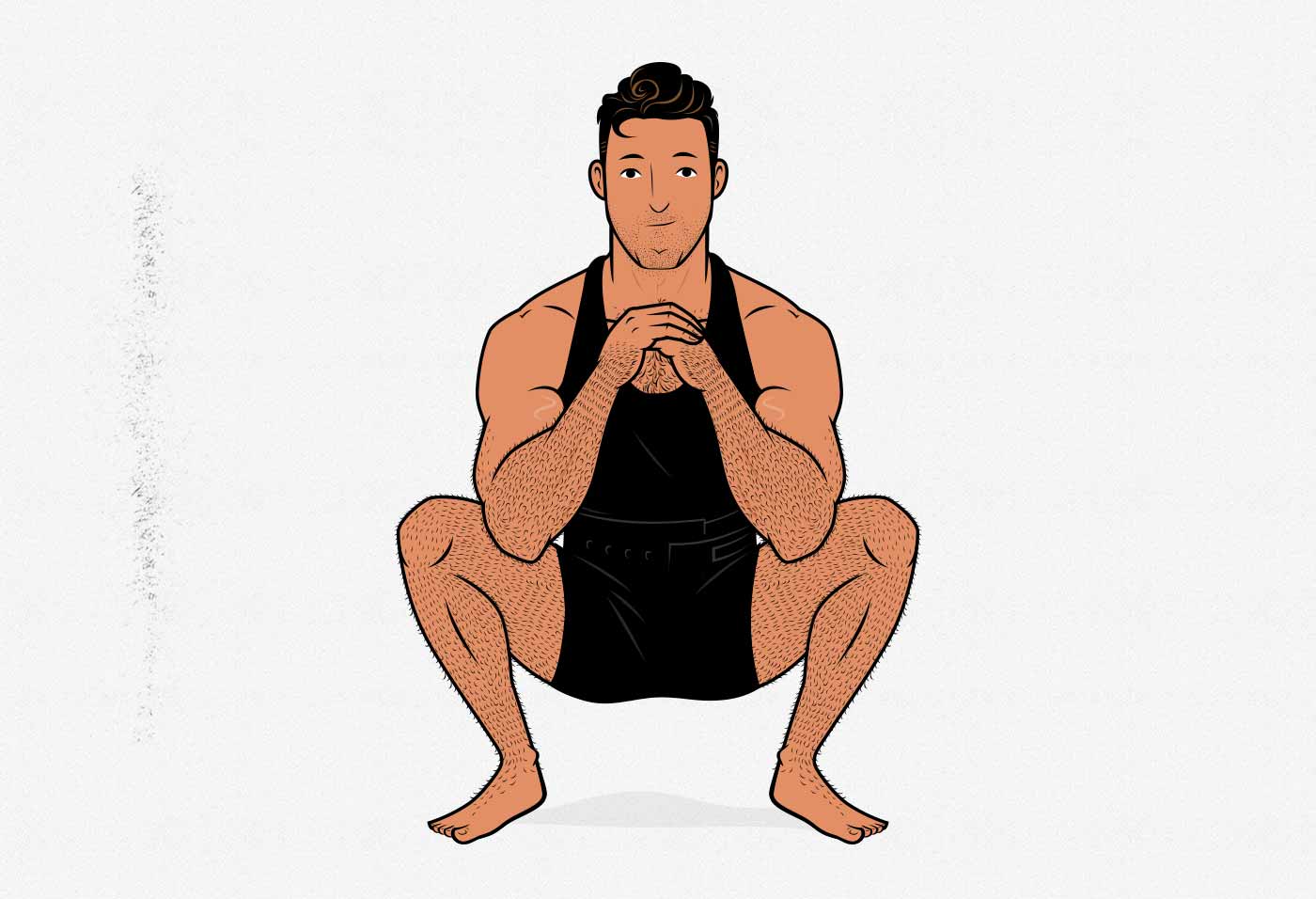
The 4 Best Bodyweight Exercises for Building Muscle
Our muscles can be broken down into muscle groups—muscles that work together to perform a movement. For example, when you do push-ups, your chest, shoulders, triceps, and serratus muscles all work together to help you push the floor away.
We want to choose a bodyweight exercise for every big movement pattern: pushing, pulling, squatting, and hinging. Those four movements will train almost all the muscles in your body, with a few notable exceptions: your calves, spinal erectors, and neck.
- Push-ups: the foundation of bodyweight hypertrophy training. Push-ups work your chest, shoulders, triceps, and abs. Start with easier variations (like raised push-ups) and work towards harder ones (such as deficit push-ups).
- Bodyweight squats: your quads and glutes are the two biggest muscles in your body. The squat trains both of them, making it the best exercise for gaining overall muscle mass. Start with easier variations (like air squats) and work towards more challenging ones (such as pistol squats).
- Chin-ups: the best bodyweight exercise for your back, biceps, and abs. You can start with lowered chin-ups or inverted rows, working towards full chin-ups.
- Bodyweight deadlifts: the hardest movement pattern to train with bodyweight exercises. You could do one-legged Romanian deadlifts or glute-ham raises, but if you want to train your spinal erectors, the towel deadlift is probably best.
These five lifts aren’t a full workout plan. They could be, but they don’t have to be. We prefer to use them as a foundation to build upon. Push-ups are all you need to build a bigger chest, but nothing’s stopping you from adding in dips. Chin-ups are great for your abs, but you could add in crunches and planks.
Just don’t lose sight of your goal. Focus on getting better at these 4 main exercises. If you can do that, you’ll do great. If your progress stalls, is it because you’re too fried or too fresh? We can then raise or lower the volume accordingly.
One: Push-Ups
Muscles Worked by the Push-Up
The lift that makes bodyweight training so good for improving our general strength and appearance is the classic push-up. In many ways, it’s comparable to the bench press. Both train the chest, shoulders, and triceps. But the push-up does a bit more than that:
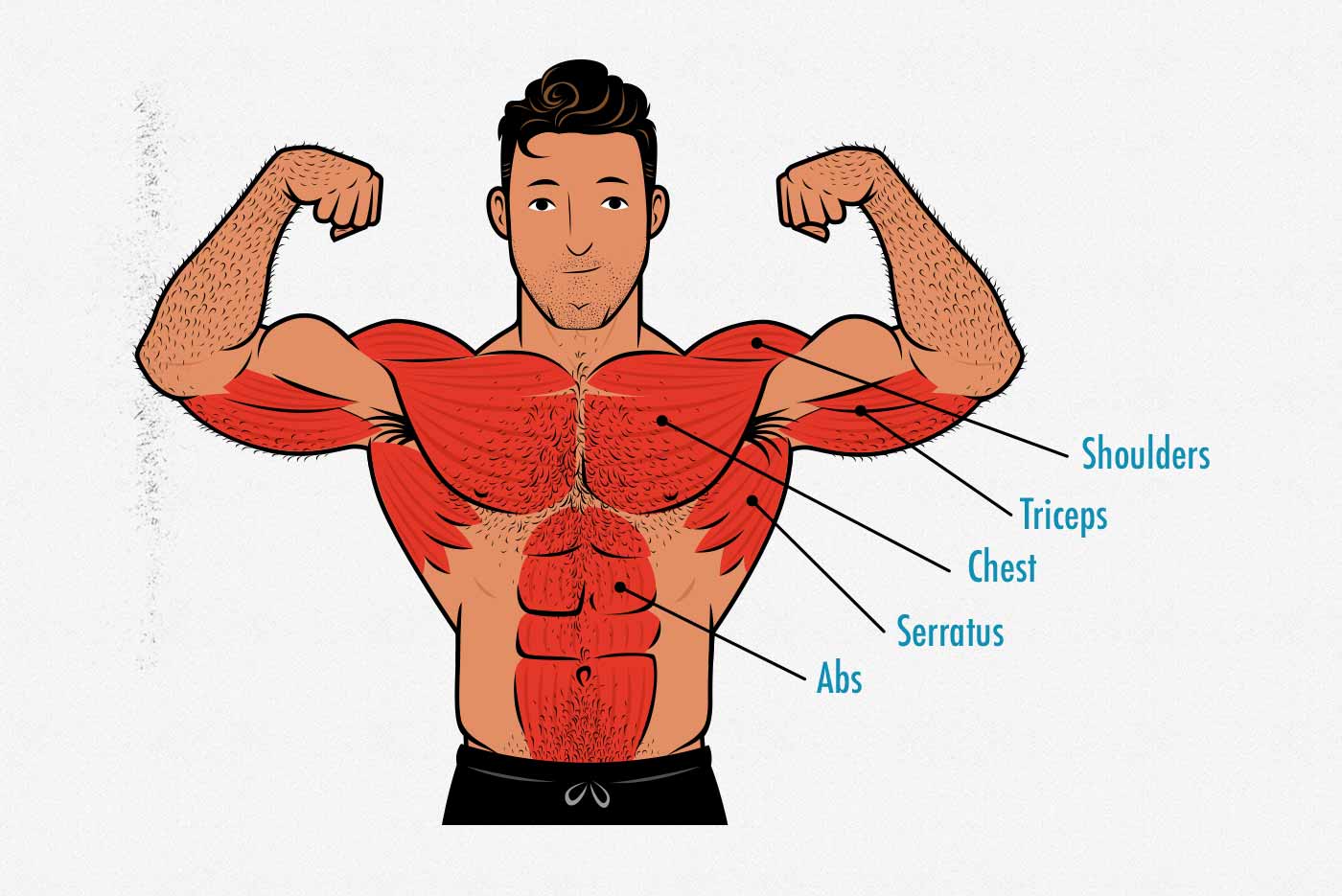
To do a push-up, we need to hold our torsos in a rigid “plank” position, making it a good lift for bulking up our abs. Plus, because our shoulder blades aren’t pinned back, the push-up is also a good lift for bulking up our serratus anterior muscles.
Min-Maxing the Push-Up for Muscle Mass
When doing push-ups for muscle growth, we want to put our hands slightly wider than our shoulders (to ensure good chest activation), with our fingers facing roughly forwards, and with our elbows tucked to around 45 degrees. There’s some flexibility here. You can go a little closer or wider, and angle your hands a few degrees—no problem. But the idea is to mimic the position of a standard-grip bench press, like so:
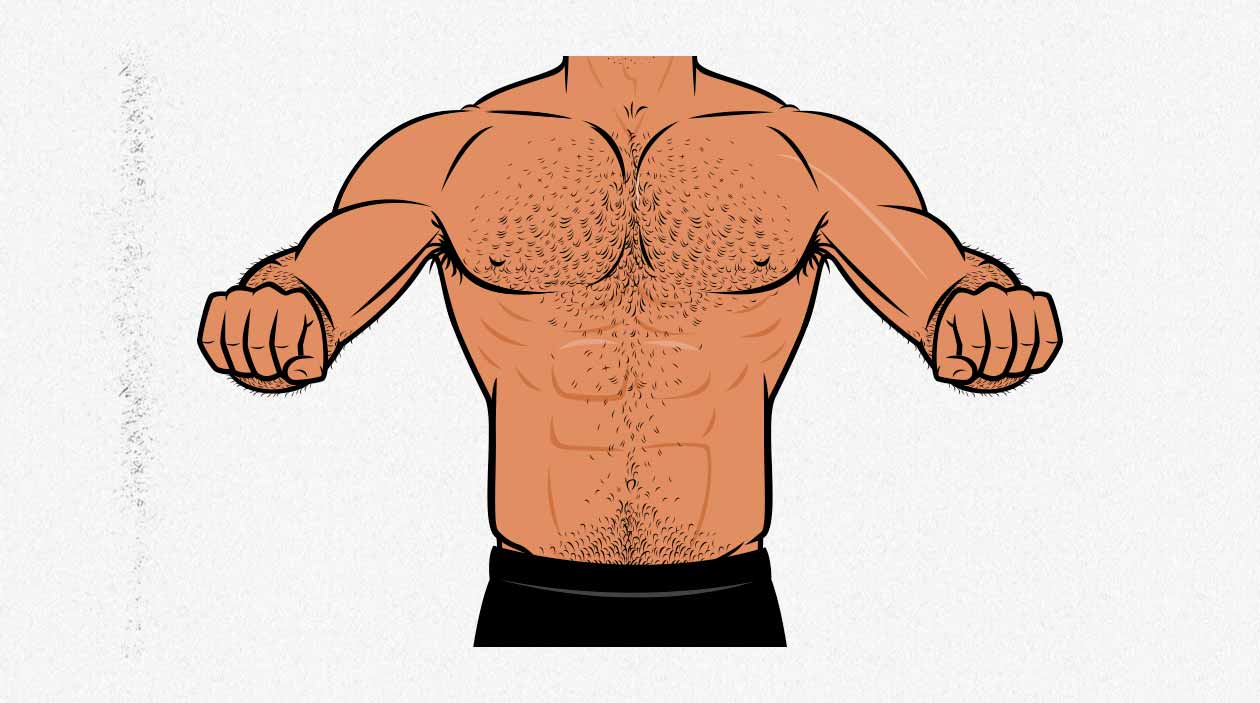
By using this moderate grip, we’re putting fairly equal emphasis on the chest, upper chest, shoulders, and triceps. It’s a great compound lift that works a ton of different muscles at once. If we go much wider, it becomes more of a chest-isolation lift. Much closer, and it becomes more of a triceps isolation lift.
The next thing is to brace your core as if you’re doing a front plank. The idea is to keep your torso rigid and solid throughout the set. Never let your hips sag, even as you approach failure. This makes it much easier to stimulate your upper-body muscles, but it’s also good for stimulating your abs and improving your posture.
Finally, we need to standardize the range of motion. For a push-up rep to count, your chest—not your stomach or nose—needs to touch the floor (or the bench if you’re doing raised push-ups). You can tuck your chin and look down or raise your chin and look ahead—either is fine. Then, when you push back up, lock your arms out (for your triceps) and push your body all the way up, fully contracting your chest and serratus muscles. Unlike the bench press, you don’t keep your shoulder blades tucked. Push the ground as far away as you can.
On that note, it’s not a bad idea to keep constant tension on your muscles throughout the entire range of motion. You don’t need to pause at the top or rest your weight on the floor at the bottom. But we still recommend going through the entire range of motion. The full range of motion standardizes technique, makes the push-up better for building muscle, and, best of all, it makes the push-up harder, reducing the number of reps you’ll be able to do before hitting failure.
How to Progressively Overload the Push-Up
The downside to the push-up is that it’s tiring in higher rep ranges. And because it’s hard to load with progressively heavier weights, it can be hard to escape those higher rep ranges. What most people do is gradually raise their feet (study):
- Knee push-ups: if you do push-ups from your knees instead of your toes, you lift 49% of your body weight.
- Hands-elevated push-ups: if you raise your hands on a tall bench (60cm), you lift 40% of your body weight. With a shorter bench (30cm), you lift 55% of your body weight.
- Push-ups: with your hands and feet on the floor, you lift 65% of your body weight.
- Feet-elevated push-ups: if you raise your feet on a short bench (30cm), you lift 70% of your body weight. If you raise your feet higher (60cm), the load increases to 75% of your body weight.
Thus, the best way to progress your push-ups is to start with your hands raised, progress to the floor, and then raise your feet.
Upgrade: Deficit Push-Ups
Muscles grow best when you challenge them in a deep stretch. It’s a huge benefit, too. Choosing lifts that work your muscles at longer muscle lengths can increase muscle growth by 2–3x. Push-ups already challenge your chest and shoulders at long muscle lengths, but deficit push-ups go even deeper, getting you slightly more growth.
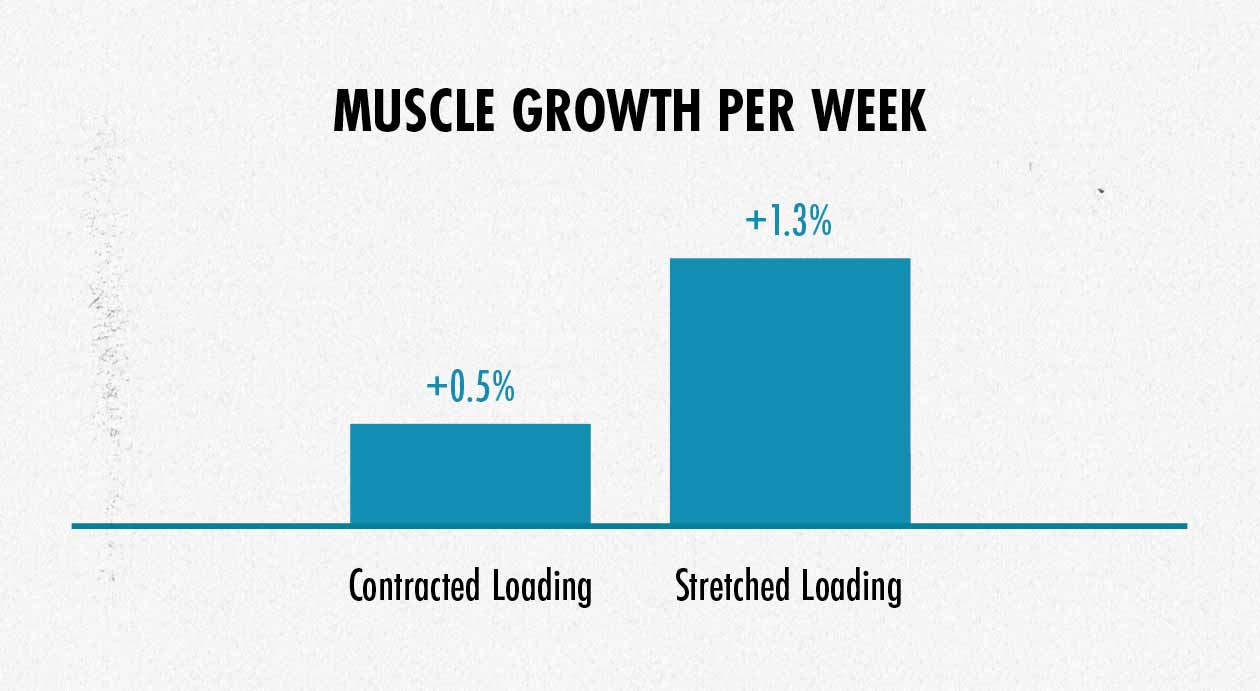
The easiest way to do deficit push-ups is to get parallettes. That’s an affiliate link from my favourite brand, Rogue Fitness. That’s where I get all of my own equipment. Cheaper variations are perfectly fine, though. These parallettes also make it easier to do pike push-ups, L-sits, and a variety of other bodyweight exercises.
Add-On: Vertical Push-Ups
The next variation of push-ups to consider is the vertical push-up. The fronts of our shoulders (front delts) are worked quite hard by regular push-ups, but pike push-ups will do a better job of working your side delts and traps, giving you broader shoulders and a more formidable upper body.
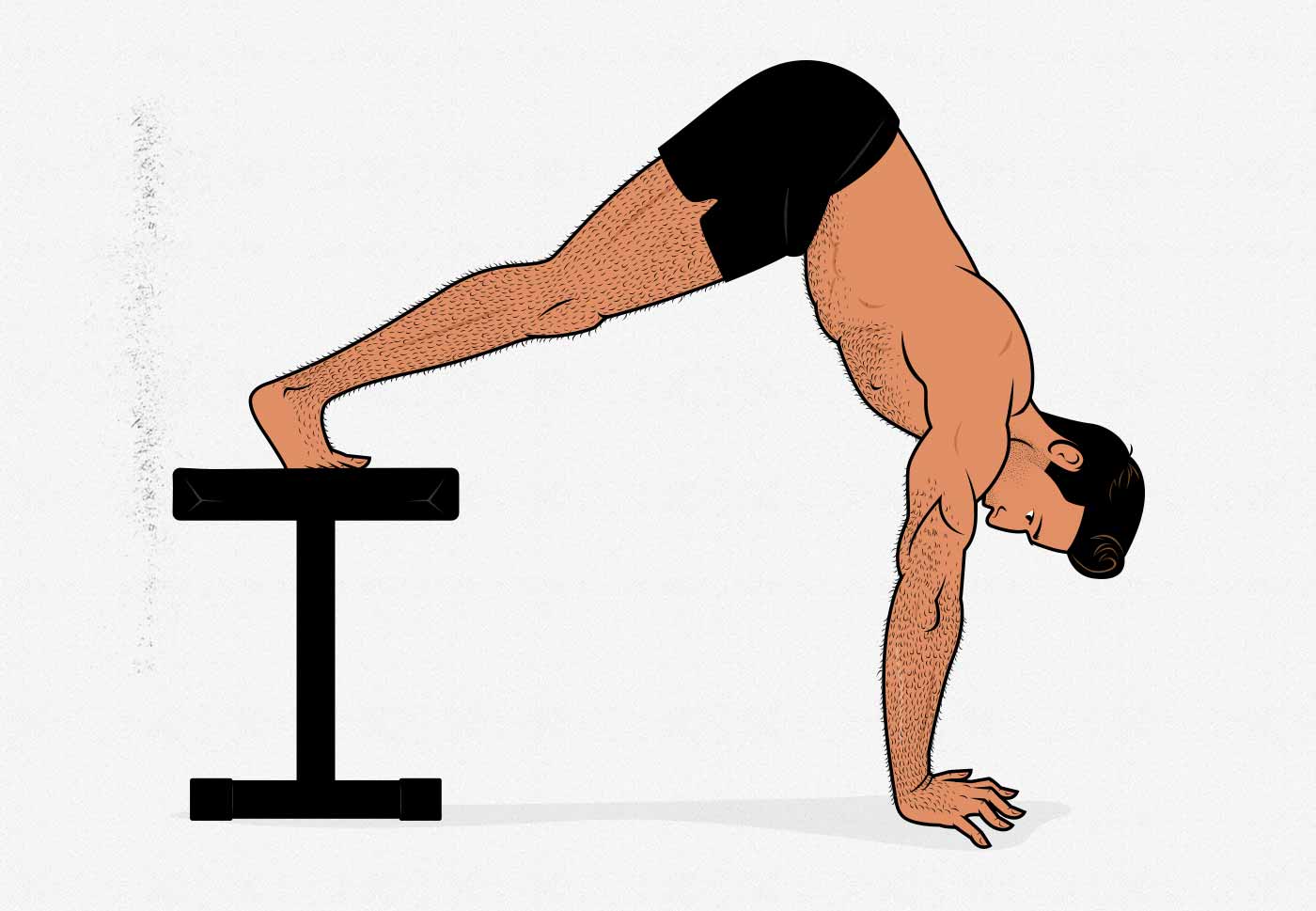
The most common vertical push-up is the “pike” push-up, done with your feet on the ground and your glutes raised high. That’s a good place to start. Then, when you’re ready, you can raise your feet up.
I like to do these in addition to my regular push-ups. You could do that by alternating between the two variations or by doing one after the other.
Two: Chin-Ups (or Inverted Rows)
Chin-ups work almost all of your pulling muscles through a huge range of motion. They’re the best exercise for bulking up your upper back, bar none. Or, perhaps I should say bar one. To do chin-ups, you need a chin-up bar or gymnastics rings. If you get gymnastic rings, you can use them to do inverted rows and dips, too. I highly recommend them. I use mine several times per week.
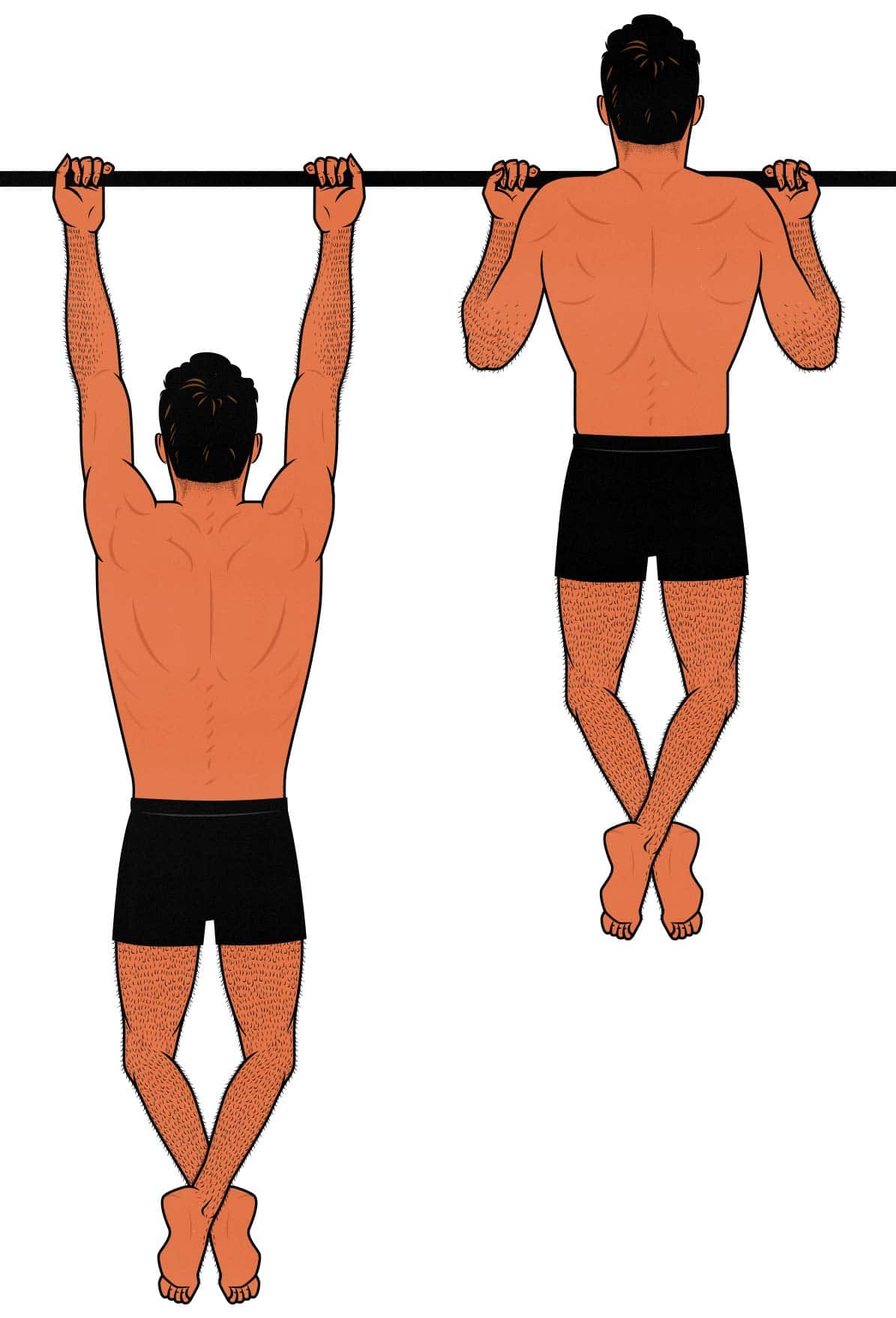
Muscles Worked by the Chin-Up
Chin-ups work most of the muscles in your upper back, with the notable exceptions of your upper traps and spinal erectors. Chin-ups are also great for bulking up your biceps, forearms, and abs. They’re especially challenging for your abs if you lift your knees up. Even more so if you do with your legs raised out straight in front of you (L-sit chin-ups).
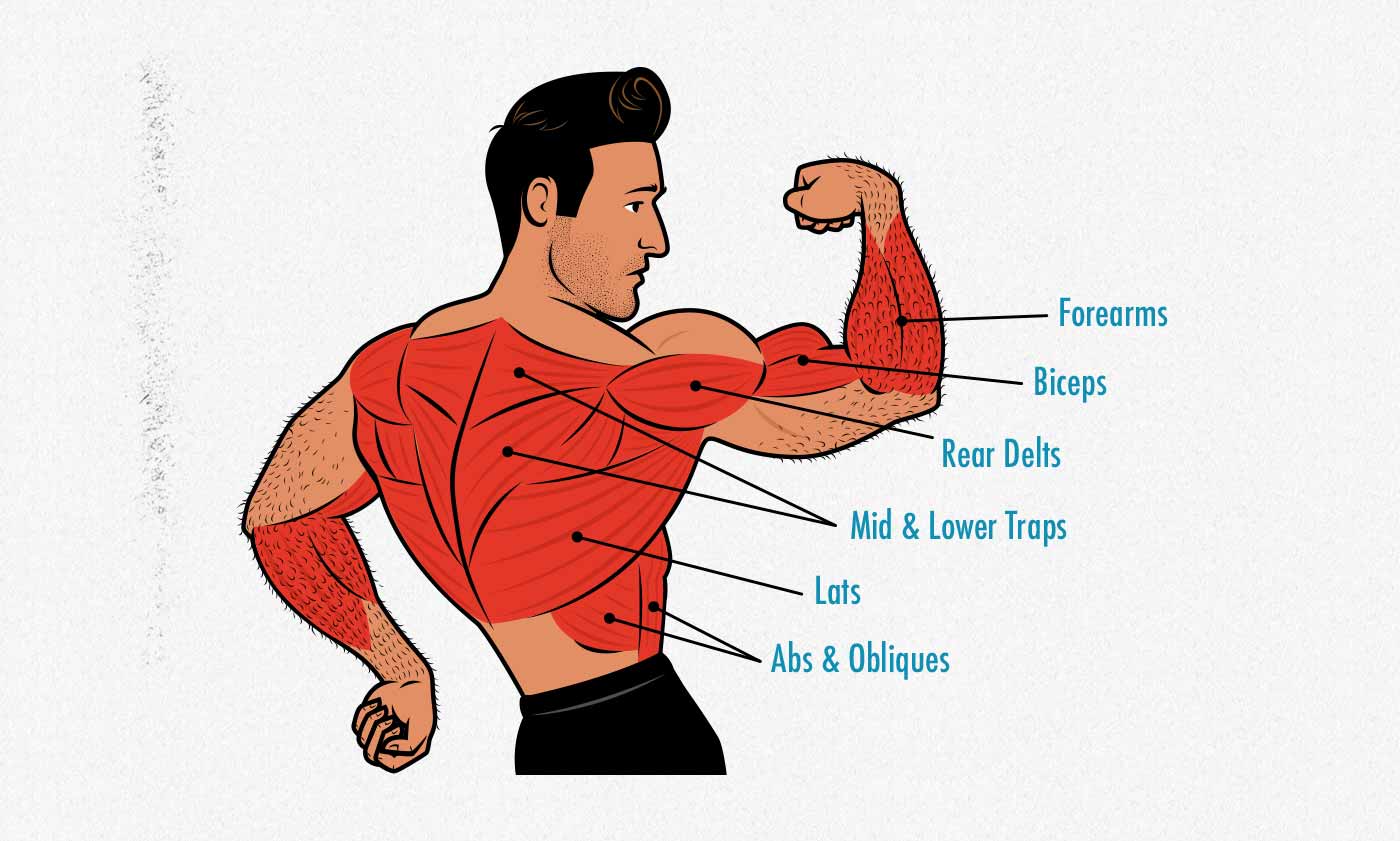
Progressing the Bodyweight Chin-Up
Most men aren’t able to do a single chin-up, let alone ten, let alone forty. As a beginner, you might not be able to do them yet.
- If you’re using a pull-up bar, you can put a stool underneath, allowing you to start in the top position. Another good beginner variation is the assisted chin-up. You’d attach a resistance band to the bar and stand or kneel on it, with one or both legs. I’m not a huge fan of resistance bands for building muscle, though. Bodyweight, dumbbell, and barbell exercises are better. So I recommend using a stool instead.
- If you’re using gymnastic rings, learning how to do chin-ups is even easier. Just lower the rings closer to the ground, starting with inverted rows. As you get stronger, raise the rings higher, giving your body a more vertical angle. Soon you’ll be doing full chin-ups.
What we recommend is using chin-ups as your main bulking lift, but then if you want to add in some extra lat work or exercise variation, add in some pull-ups. Your biceps will thank you.
That gives us a chin-up progression system that looks like this:
- Lowered or supported chin-ups until you’re strong enough to do at least a few reps.
- Regular chin-ups. You can also do variations like pull-ups to emphasize your lower lats and knee-raised chin-ups to emphasize your abs.
Three: Bodyweight Squats
Muscles Worked by Bodyweight Squats
The sheer amount of muscle being worked by squats is wild. Your quads alone are 7x as big as your chest. Your glutes are 5x as big as your chest. Even your calves are nearly 3x bigger than your chest. This makes squats several times bigger than push-ups and chin-ups combined.
On the bright side, bodyweight squats are incredibly good for building muscle. However, they’re also fearsomely tiring and brutally painful. If you aren’t careful, they can easily test your grit instead of your strength.
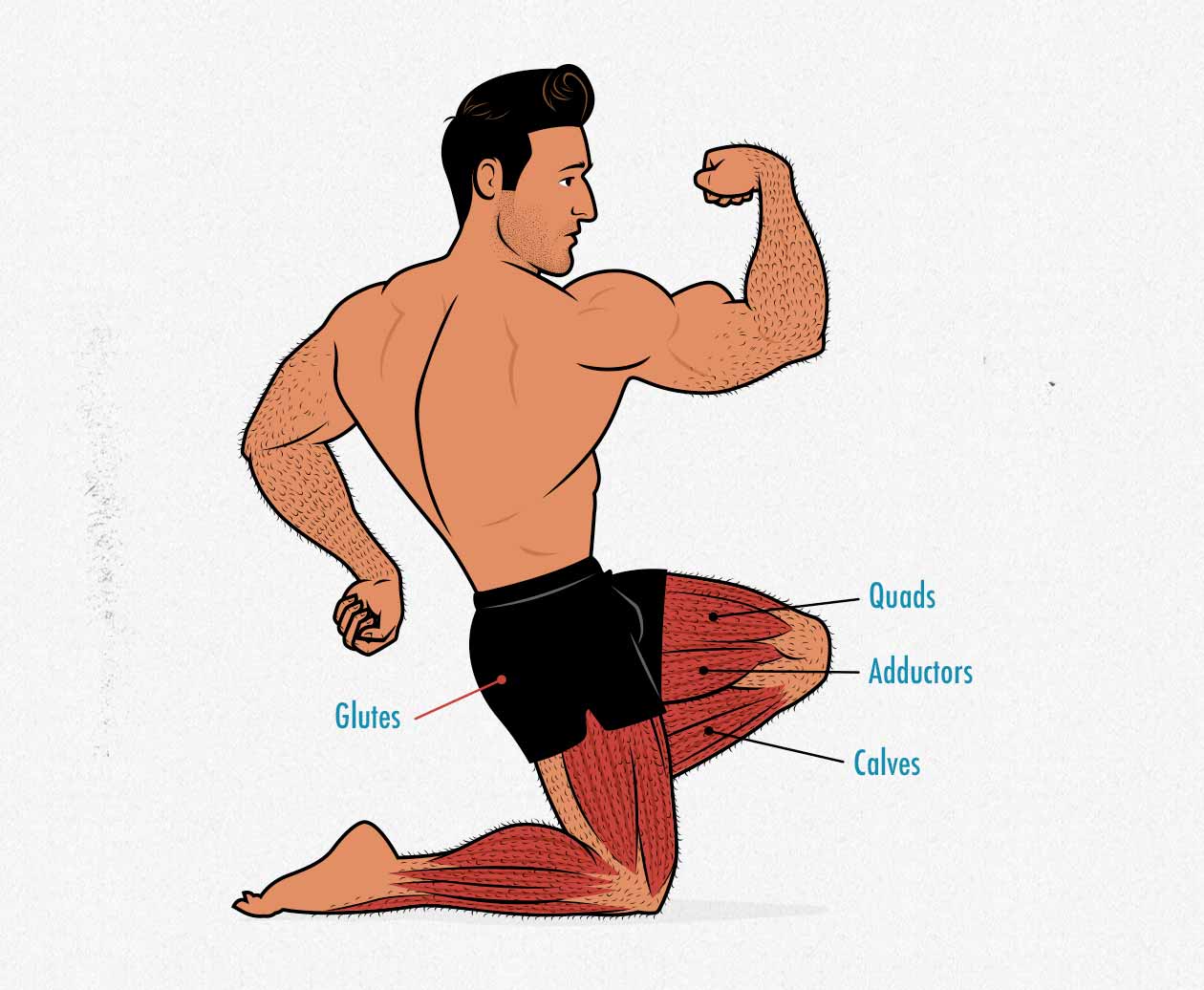
Progressing Bodyweight Squats
The first and easiest bodyweight squat progression is the air squat. Hold your hands in front of your body, try to keep your torso as upright as possible, and sit down (not back). You can keep your hands close (as pictured below) or hold them out in front like a zombie. If you have a shorter torso, the zombie approach tends to work better.

The problem with air squats is that they quickly become too easy. Even as a beginner, you may already be able to do 20+ reps before hitting failure. And as the rep range climbs higher, squats become extremely metabolically taxing. We need to make them harder.
One way to progress the air squat is to load up a bag with books and hold it in front of you. If you can read quickly enough, you could add a new speculative fiction novel to the backpack every week, making it gradually heavier. But even if you have a big backpack and like to read heavy books, you’ll quickly grow too strong for them.
When air squats become too easy, you can make them harder by jumping—jump squats. Your muscles will need to work harder to launch you into the air. Then, when you land, your muscles need to decelerate you. This is nice because you need to generate the force at the bottom of the range of motion when your quads and glutes are stretched. That’s great for stimulating muscle growth.
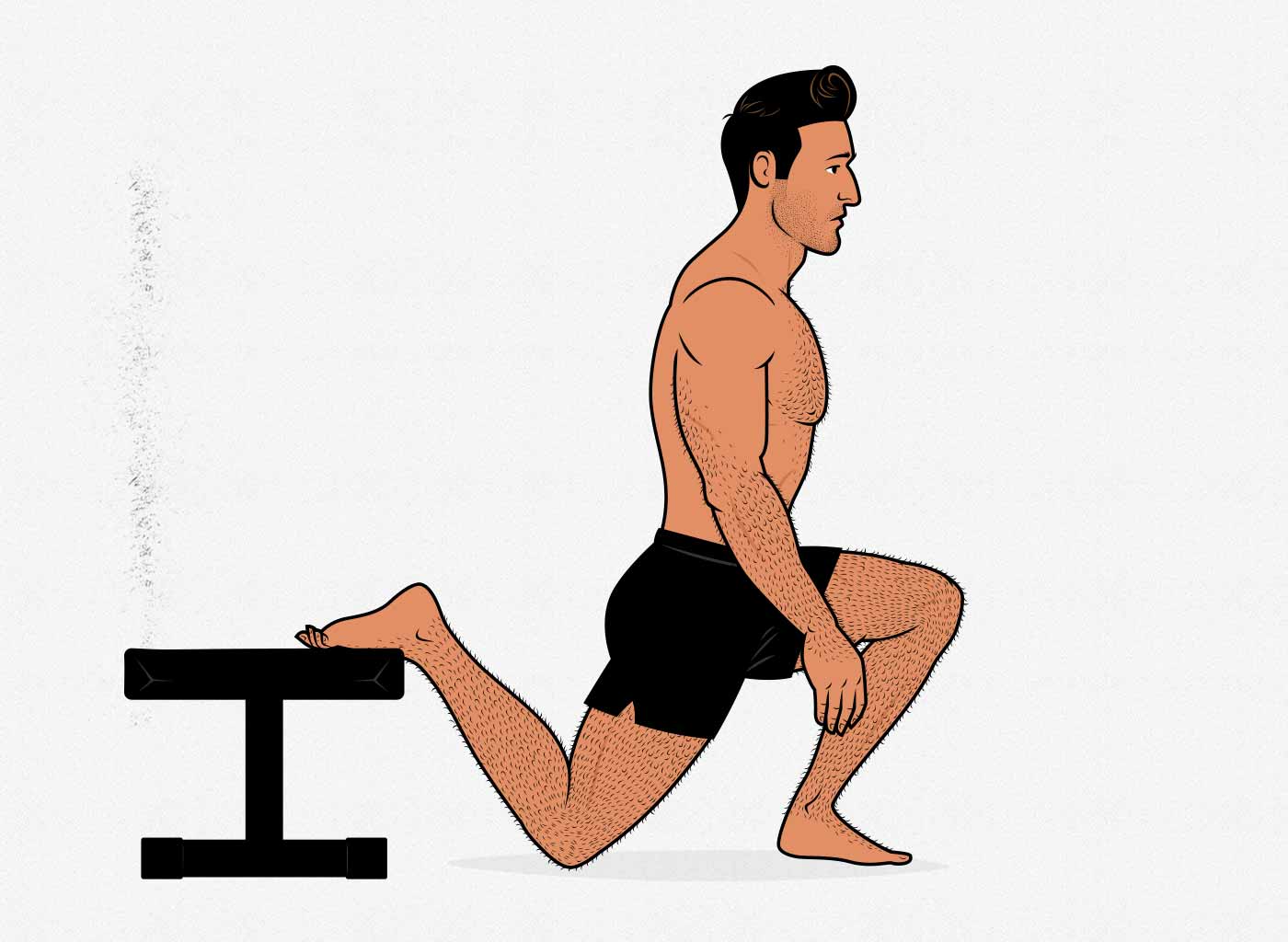
When you grow too strong to train both legs at once, you can switch to doing split squats. Split squats are great because they don’t just drop the range lower; they also cut the muscle mass you’re working in half, making the lift much easier on your cardiovascular system. You can make those split squats more difficult by raising your back leg up—the Bulgarian split squat.
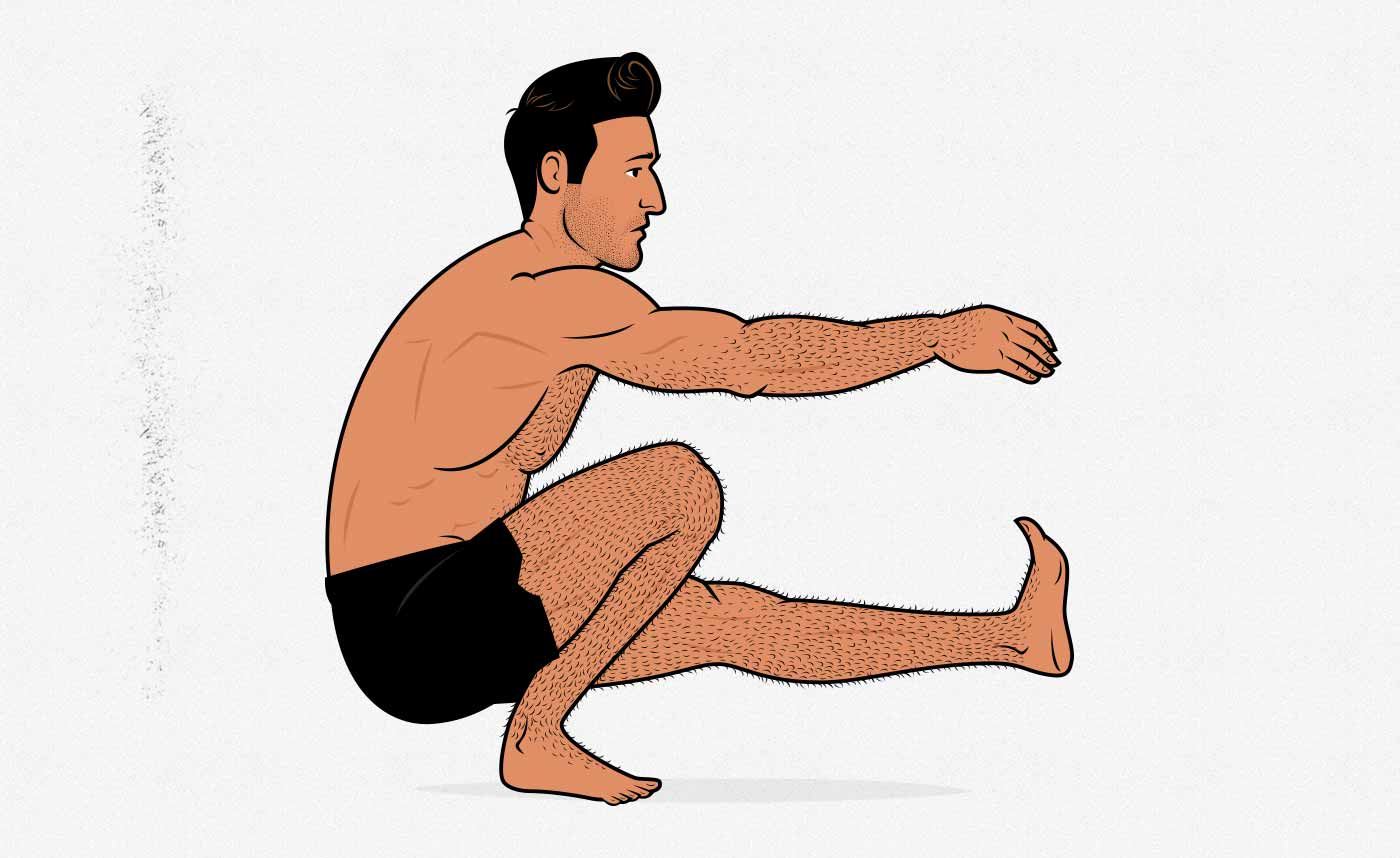
The pistol squat (or rifle squat if you’re on the taller side) puts all your weight onto one leg. If you can do 40 air squats, you may only be able to do a few pistol squats. If you’re having trouble balancing, don’t be afraid to hold onto something for support. The point is to work your quads, not to win a balance competition.
That gives us a bodyweight squat progression that looks like this:
- Air squats until you can do 20 reps. You can get some extra mileage out of these by loading up a bag with books and holding it in front of you. You can also do jump squats, trying to jump as high as possible with every rep.
- Bodyweight split squats until you can do 20 reps with each leg. As with air squats, you can hold a heavy bag in front of you to make them harder. You can also raise your back leg on a bench.
- Pistol squats. Hold something for balance if you need to.
Four: Bodyweight Deadlifts
The Mighty Towel Deadlift
Finding good bodyweight alternatives to the deadlift is tricky because the whole point of the deadlift is to put a heavy load on your spine, traps, and spinal erectors. There are plenty of bodyweight deadlift variations that work your hips to some degree or another, but hardly any of them work the muscles in your posterior chain (such as your spinal erectors).
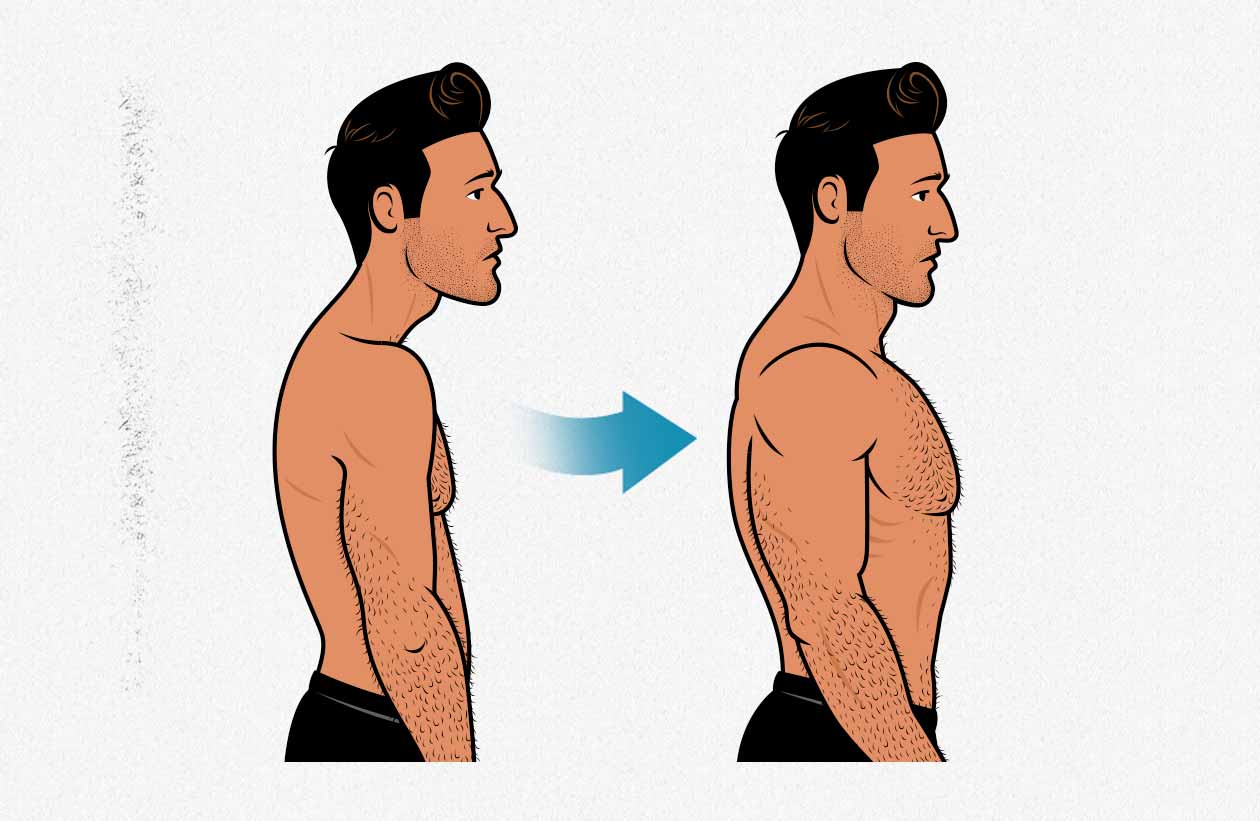
That’s why my favourite bodyweight deadlift variation is the towel deadlift. You stand on a towel and pull on it, just like you’d pull on a barbell. The difference is that this is an isometric lift—no range of motion. No matter how hard you pull on the towel, it will not move. You’re locked in the bottom position.
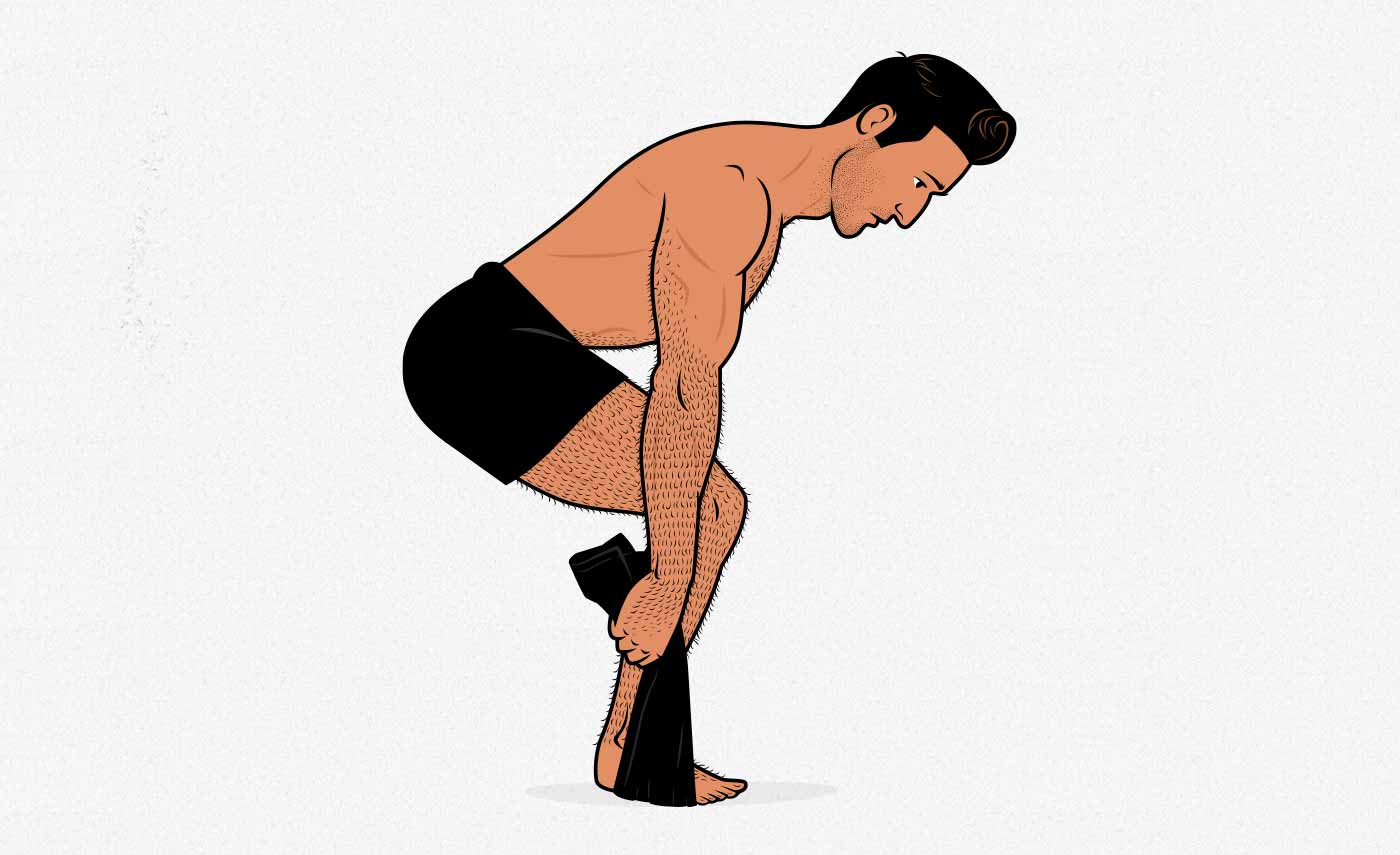
Isometrics that challenge your muscles in a stretched position are good for building muscle. The towel deadlift is done with a deep hip angle, challenging your glutes and hamstrings in a stretched position.
Muscles Worked by Towel Deadlifts
The other great thing about the towel deadlift is that it trains your entire posterior chain. As you pull on the towel, your spinal erectors and mid-back muscles need to work just as hard as if you were pulling on a too-heavy barbell. And because you need to grip the towel, your forearm muscles get worked, too.
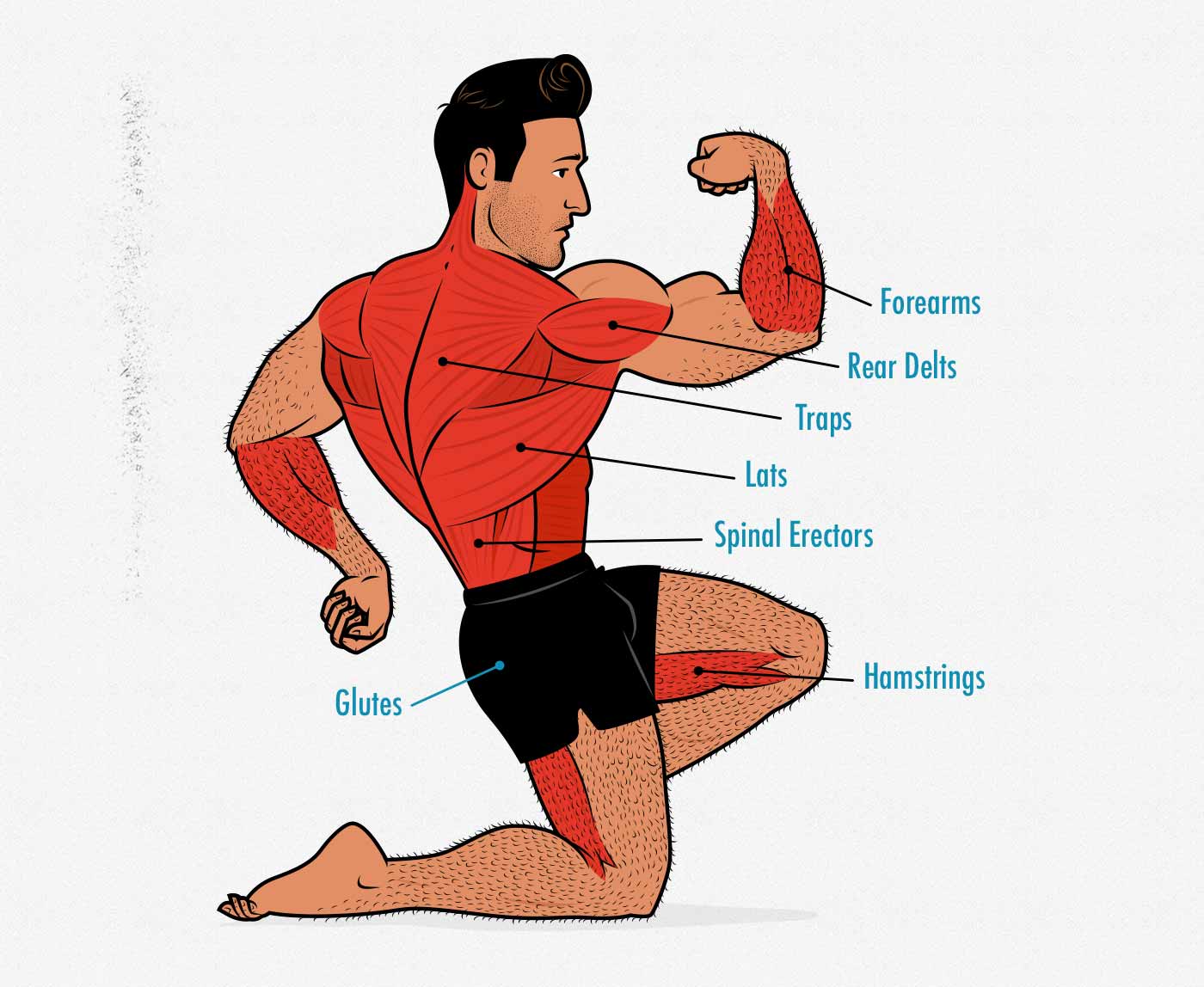
Progressing Towel Deadlifts
The nice thing about pulling against a stationary object is that the bigger and stronger you get, the harder you can pull. If you give each set your all, progressive overload is built right into the lift.
When doing towel deadlifts, we recommend using burst reps. Pull as hard as you can for a few seconds, then release the tension. That’s your first rep. Then pull as hard as you can for another few seconds. That’s your second rep. You can progress how many seconds you pull for, and you can adjust how many reps you do per set. For example:
- Week One: 3 sets of 3 reps (3×3), with each rep lasting 5 seconds.
- Week Two: 4 sets of 3 reps (4×3), with each rep lasting 6 seconds.
- Week Three: 4 sets of 4 reps (4×4), with each rep lasting 7 seconds.
Add-On: Hip Thrusts
The problem with the towel deadlift is that the range of motion is zero. And as a general rule, we want to gain strength through a large range of motion. That’s a crucial aspect of being generally strong, and it’s also the best way to build muscle. It doesn’t matter much with our spinal erectors since their purpose is to hold our backs rigid, but it does matter with our hips, which are designed to move. So, in addition to doing deadlift isometrics, we recommend including some other hip hinges, such as the hip thrust.
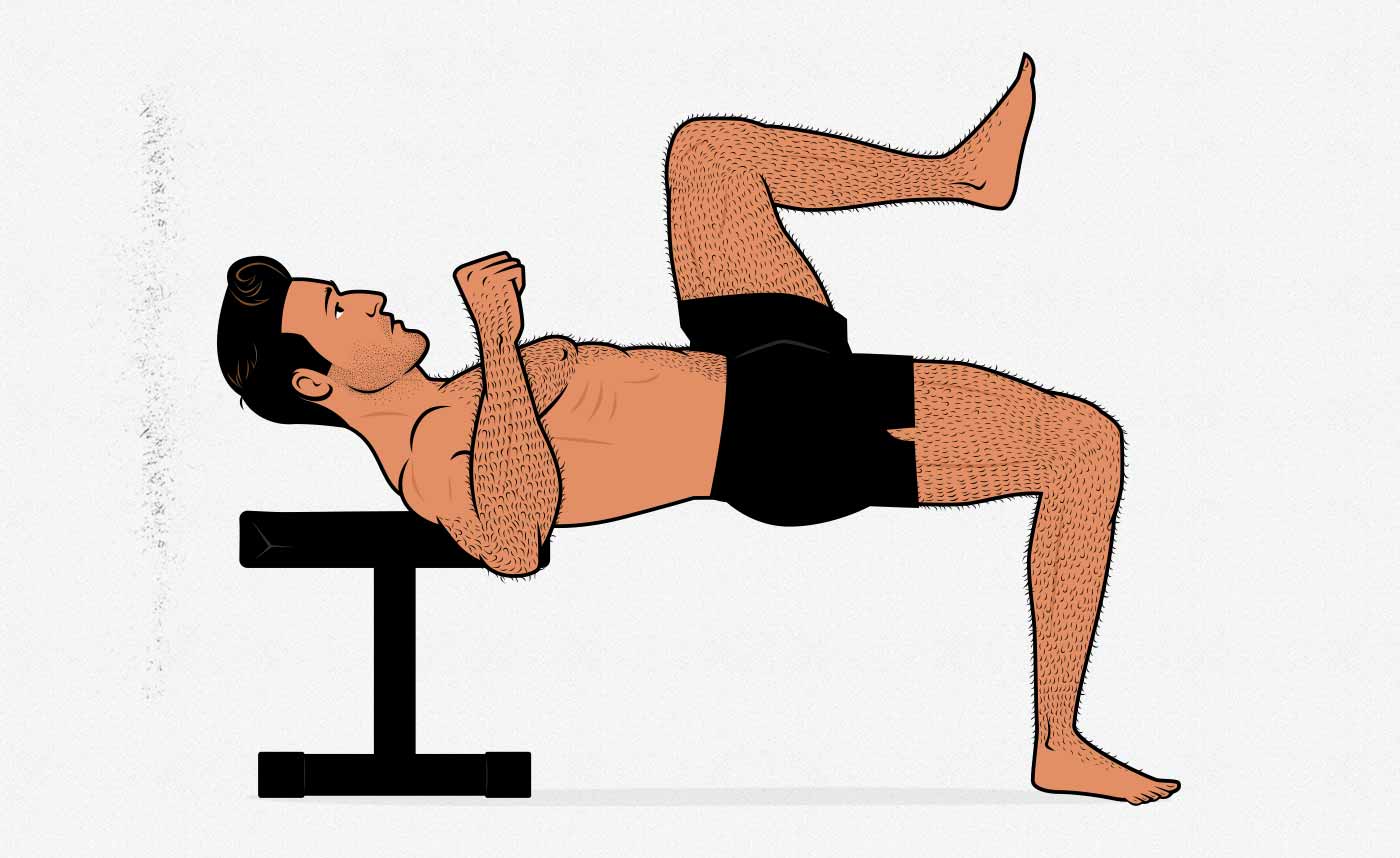
For the hip thrust, there are a few progressions:
- Glute Bridge: start with regular glute bridges until you can do at least twenty reps, but feel free to stick with it until you can get as many as forty.
- One-Legged Glute Bridge: once you can do 20–40 reps with both legs on the ground, switch to single-leg variations and work your way back up to 20–40 reps.
- Hip Thrust: when you can do 20–40 reps of one-legged glute bridges, switch to doing hip thrusts with your back on a bench. Feel free to put a backpack loaded with books in your lap to make the lift harder.
- One-Legged Hip Thrust: When you can do 20–40 reps, switch to using a single leg at a time, and work your way back up to forty reps.
Bodyweight Isolation Exercises
After you’ve done a couple of the main movements, you can move to the smaller movements. With the main movements, we recommend training pretty seriously. With the accessory and isolation lifts, you can approach it much more casually. Pick a few exercises that interest you for the muscle groups you’re most eager to grow and try to improve at them a little bit every workout.
There are a ton of different accessory and isolation lifts that you can add to your bodyweight muscle-building routine. Here are some of our favourites.
Abs & Obliques
- Hanging leg raises
- Planks and side planks
- Sit-ups and crunches
- Offset push-ups
- Dead bugs (I love these as a warm-up drill)
Biceps, Triceps & Shoulders
- Dips using parallel bars or rings (chest, triceps, upper back)
- Close-grip chin-ups (biceps & rear delts)
- Bench dips (triceps)
Chest & Back
- Wide-grip push-ups
- Pull-ups
- Muscle-ups (advanced)
Legs & Glutes
- Single-legged Romanian deadlift
- Hip thrusts (and single-leg hip thrusts)
- Glute bridges (and single-leg glute bridges)
- Straight-leg bridges
- Sissy squats
The Bodyweight Workout Routine
Okay, so we’ve gone over the 4 best beginner bodyweight exercises, and we’ve talked about how to progress them:
- The push-up: Start with raised push-ups and work towards deficit push-ups.
- The squat: Start with air squats and work towards pistol squats.
- The chin-up: Start with lowered chin-ups (or table rows) and work towards full chin-ups, perhaps even emphasizing one arm at a time.
- The deadlift: Start with towel deadlifts, doing them longer and harder each workout. Consider adding bodyweight hip thrusts for hip development.
That gives you the foundation of your program, and if you’re a beginner, that may be all you need. You could simply do those 4 exercises three times per week. You can do that with 3 full-body workouts per week or split it up into more workouts. For example, if you wanted 6 short workouts, you could do the lower-body lifts one day, and the upper-body lifts the next.
3-Day Full-Body Bodyweight Workout Routine
- Monday: big 4.
- Tuesday: rest.
- Wednesday: big 4.
- Thursday: rest.
- Friday: big 4.
- Saturday: rest
- Sunday: rest
6-Day Upper/Lower Bodyweight Workout Split
- Monday: push-ups, vertical push-ups, and chin-ups.
- Tuesday: squats, towel deadlifts, and hip thrusts.
- Wednesday: push-ups, vertical push-ups, and chin-ups.
- Thursday: squats, towel deadlifts, and hip thrusts.
- Friday: push-ups, vertical push-ups, and chin-ups.
- Saturday: squats, towel deadlifts, and hip thrusts.
- Sunday: rest.
I would start with a low volume and work your way up. Something like this:
- Week One: two sets of each lift to ease into the routine (and prevent crippling muscle soreness).
- Week Two: three sets of each lift to step up the training volume.
- Week Three: 3–4 sets of each lift, doing more sets for your favourite lifts.
From there, you can increase training volume as needed or desired. If you’re failing to make progress on your lifts, consider doing more total sets. Or, if you’re struggling with crippling soreness or fatigue, consider doing fewer sets. Everyone responds best to slightly different training volumes.
As you gain more experience, feel free to experiment:
- Add in assistance and accessory lifts.
- Experiment with short rest times, circuits, and drop sets.
- Raise the volume higher for the lifts you’re most eager to get better at.
And, of course, this is just a loose recommendation. Feel free to customize your routine as you see fit. As you get deeper into bodyweight training, you’ll be able to see which muscles are getting stimulated during your workouts, which muscles get sore afterwards, which lifts you get better at, and which muscles see the most growth.
Should You Ever Get Free Weights?
Bodyweight training can be a bit finicky, and as you get stronger, the pain of doing compound lifts in higher rep ranges can make it downright brutal. Thus, at some point, most people decide to invest in some free weights.
- Here’s our guide for how to build a barbell home.
- Here’s our guide for how to build a dumbbell home gym.
Conclusion
Bodyweight training can be painful, but if you don’t have access to free weights, you can absolutely bulk with just your body weight. Also, keep in mind that some bodyweight lifts, such as the push-up and chin-up, easily rival the big free-weight lifts, making bodyweight training great for building a big chest and upper back.
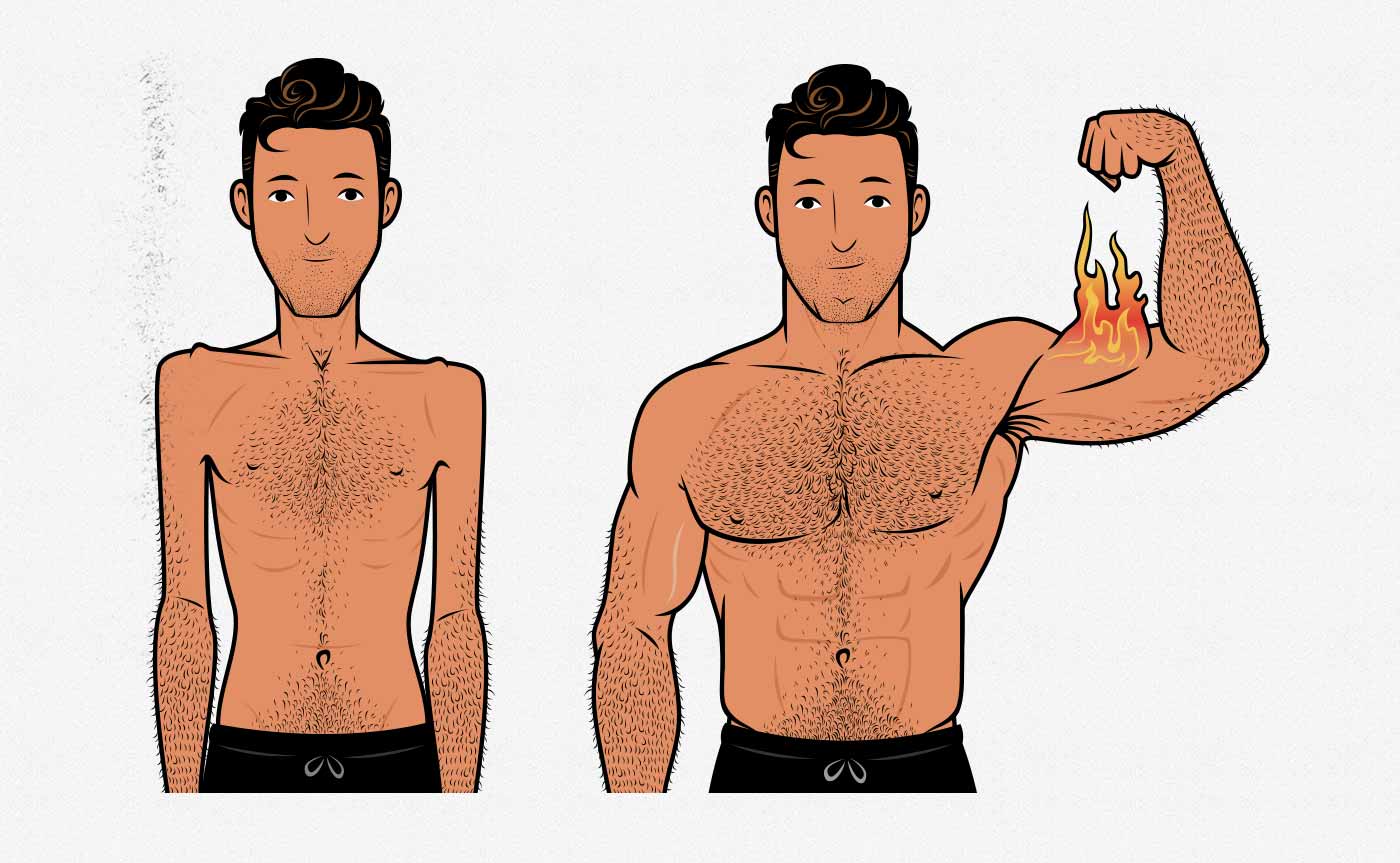
We recommend splitting up your bodyweight training into 4 foundational movements:
- Push-ups train your chest, shoulders, triceps and abs. You can start with raised push-ups and work towards deficit push-ups.
- Bodyweight squats train your quads and glutes. You can start with air squats and work towards jump squats and pistol squats.
- Chin-ups train your upper back, biceps, and abs. You can start with lowered chin-ups (or inverted rows) and work towards full chin-ups.
- Bodyweight deadlifts train your spinal erectors, upper traps, hips, and grip. You can combine heavy towel deadlifts with hip thrusts to develop your posterior chain and hips.
There are a few ways you can progressively overload bodyweight exercises:
- Add reps: the heart of bodyweight training is gradually adding reps from workout to workout. If you do 50 push-ups in one workout, your goal for the next workout is to get at least 51. This works incredibly well for stimulating muscle growth.
- Choose more difficult variations: as you get better at the bodyweight lifts, you can gradually progress to more difficult variations. However, this doesn’t happen from workout to workout, it happens from month to month. This progression is too fast. We need something more gradual.
- Gain weight: as you bulk up, you’ll be gradually gaining weight, which will make your bodyweight training heavier over time. This helps quite a bit, but the progression is too slow. Your growing strength will outpace your growing body.
- Add sets: as you grow stronger and fitter, you’ll be able to tolerate more sets per workout. In your first week, two sets per exercise are plenty. In your second week, three sets per exercise are better. And from there, you can progress to four, five, or even more sets per exercise per workout.
Our muscles grow best when we train them 2–4 times per week, so as a good default, we recommend doing each of the movements three times per week. You can do that with three full-body workouts per week, or you can split them up over more days. For example, you could just as easily do a six-day routine, doing the upper-body lifts one day and the lower-body lifts the next.
Feel free to customize the workouts as you see fit, including adding isolation and accessory exercises, adjusting your training volume, and adjusting your training frequency.
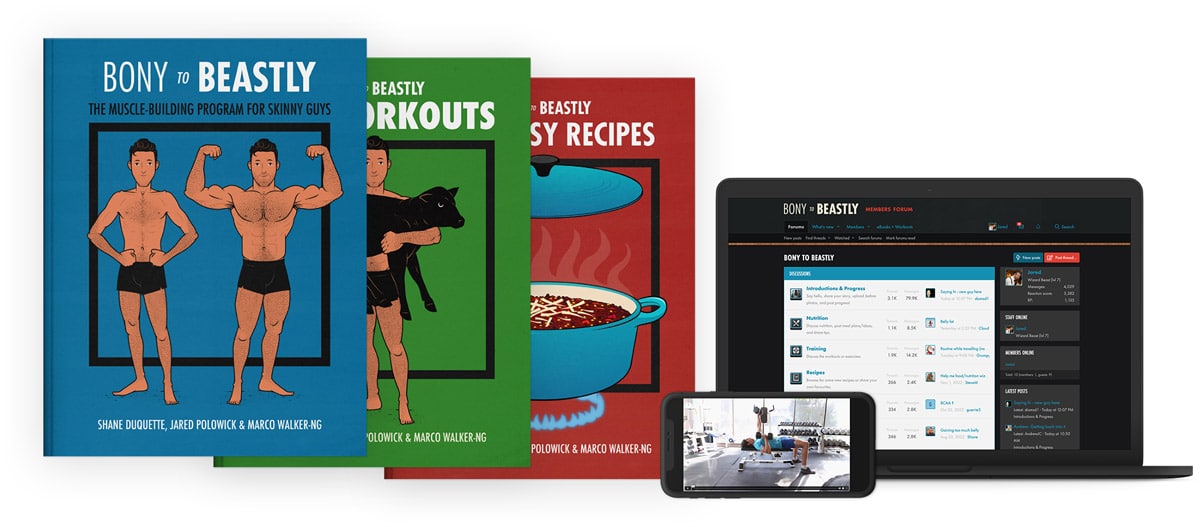
If you want more muscle-building information, we have a free bulking newsletter for skinny guys. If you want a full bulking program, including a 5-month workout routine, diet guide, recipe book, and online coaching, check out our Bony to Beastly Bulking Program. Or, if you want an intermediate bulking routine, check out our Outlift Intermediate Bulking Program.
Muscle-Building Mini-Course via Email
Sign up for our 5-part muscle-building mini-course that covers everything you need to know about:
- Hardgainer genetics and how to make the most of them.
- How to take a minimalist approach to building muscle while still getting great results.
- What you need to know about aesthetics, health and strength while muscling up.



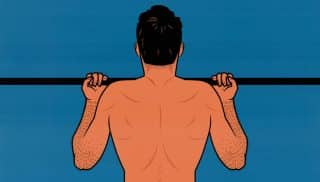
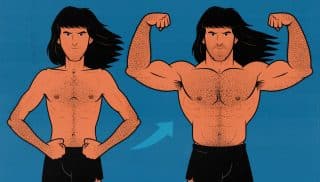
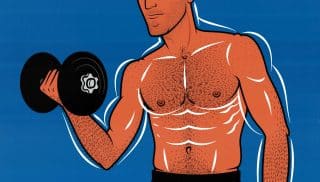
Such a great article, I love it!
I’m living in self-isolation for eight weeks now and I’ve experienced great results from doing bodyweight training! I saw the self-isolation as an opportunity to go from maintaining mode to bulking mode again and I went from 155lbs to 165lbs (@5ft8) over the course of these eight weeks! This while I already had a decent physique after 4-5 years of lifting (I’ve also done B2B a few years back 😉 ).
During your research, did you guys find anything about the effectiveness of one-arm push-ups and side-to-side (deficit) push-ups? I’ve learned these from Kinobody online and I was wondering if those were great options too. If not, I might as well substitute them with high-rep weighted deficit push-ups.
Thanks in advance!
That’s awesome, Vincent! And thank you 🙂
I checked out Kinobody’s stuff while writing this article and I think his approach to bodyweight training is pretty solid. He seems like one of those guys who’s always blended bodyweight training into his lifting, always doing chin-ups, one-arm push-ups, chin-ups, and so on. I think he’s become quite good at making the most of it.
The trick with one-arm push-ups is that they’re good for building, sure, but they’re less of a chest exercise, more of a shoulder and oblique exercise. So if you’re trying to progressively overload your chest, it doesn’t make that much sense to be shifting your push-up weight around. Better to stick to deficit push-ups for as long as you can. You can do deficit push-ups with your feet raised to make them harder. I’ve seen that Omar Isuf has been making progress with those during the lockdown, and I think he benches like 400 pounds? And that’s without loading books into a backpack, either. Deficit push-ups can take you far!
Do a few sets of deficit push-ups and see how your chest feels compared to when you do a few sets of one-arm push-ups, both in the moment and also a couple of days later. I think you’ll feel more of a burn and get more DOMS. Not that those are always the best indicators of muscle growth, but it’ll be obvious that your chest is getting the brunt of the load 🙂
(Kinobody also recommends those side-to-side (archer) chin-ups and pull-ups, and I think that’s a neat idea. They wouldn’t have the same downsides as the one-arm push-ups. They’re still a back and biceps exercise. And again, I think his bodyweight content is really good overall.)
Awesome article. This is perfect as I’m about to come back home with only resistance bands and some towels to mess with. After a 4 month cut, I’m dreading not having a gym!
Miss the B2B team btw. I remember when I found your site in 2014 and it changed my life. Fell off the wagon 2 years ago and hopped back on and been reading your posts again. You guys are crushing it.
Thank you, Nick! Always great to hear from you, man 😀
Hi! Thank you for this very informative – and much needed in these times! – article. You have written that a push-up grip slightly wider than shoulder-width is best for hitting the chest. Have you seen this research paper that I have linked to below? It basically compares narrow grip with shoulder grip and wide grip and reaches the conclusion that the narrow grip is actually best for optimizing both triceps AND chest growth:
Kind regards Andreas
Hey Andreas, that’s a good question.
So, that’s a study looking at muscle activation using electromyography (EMG). With EMG research, muscle activation tends to register the highest when our muscles are in a contracted position. With a narrow-grip push-up, the pecs are working at shorter muscle lengths and getting a stronger contraction. It makes sense, then, that the narrow-grip push-up would have higher EMG ratings.
However, higher EMG ratings don’t necessarily translate to more muscle growth. In fact, because our muscles grow best when challenged at long muscle lengths (as covered in the article), we want to do the exact opposite of that. We want to use deficit push-ups to really challenge our pecs in a stretched position. The muscle lengths are longer overall and the contraction at the top isn’t as intense, but it doesn’t matter because it’s the bottom part of the lift that’s stimulating most of the muscle growth 🙂
Hey Shane, thanks for your reply, that makes sense! 🙂
This is a great article with a very that is a complete beginners guide to bodyweight exercises
I am 74 years old and use Gymnastic Rings and Paralettes as my equipment. Check outy IG @kanti.chiba
Thank you, Kanti! Gymnastics rings are awesome. It’s impressive what you can do at your age, too 🙂
Hi
Seeing as we’re all stuck in this lockdown I was hoping to begin home workouts and found your article. Let me first say, thank you for such a detailed article. I’m a 6ft tall guy but weigh only 66kg. I’ve tried going to the gym before but I start losing weight even though I’m eating a lot. I wanted to ask if you can give me a good diet for bulking? I don’t want to take supplements but if they’re really necessary, please talk about them as well. I just need guidance regarding what to to eat and portion control, and especially when to eat it. What to have before the workout and what to have after? I’m just really confused as there’s a lot of conflicting information out there. Thank you once again
Hey Farhan, I hear ya. I started out at 6’2 and 59 kilos, and I had that same problem of losing weight whenever I tried to build muscle or live a healthier lifestyle. We’ve got an article on how to eat more calories, another article going over some good bulking foods, and a third article about the best bulking supplements for skinny guys 🙂
I hope that helps, and good luck!
I’ve been following this Men’s Health bodyweight workout here for a while now for 5 days on, 2 days off (3 chest, 1 arms, 1 legs).
What do you think of those exercises/that routine in terms of effectiveness, and what exercises would you recommend to add if I have some adjustable dumbells at home? Thanks for any advice in advance.
Hey Hashim, if you’re liking the workout and it’s working well for you, I think that’s great, and you can definitely keep doing it.
But I don’t think this workout makes a lot of sense. If I’m understanding it right, they recommend a wide slew of bodyweight exercises with arbitrary rep ranges and no progression over time. For example, 15 reps of wide-grip push-ups followed by 15 reps of one-arm push-ups. But if someone can do 15 one-arm push-ups, then doing 15 wide-grip push-ups would be far too easy. And then next week do the exact same thing? It doesn’t make any sense.
The details are wrong, too. They’re recommending eighteen sets for the chest 2–3 times per week. Muscle growth is maximally stimulated with 3–8 sets per workout. Doing 18 sets is such overkill that the excessive muscle damage they cause may even impair growth.
I know this sounds self-serving, but I’d recommend the approach explained in our article. Variations should be chosen based on your strength, you should do the number of reps that brings you within 0–3 reps of failure, 3–8 sets per muscle group per workout is enough, and there needs to be progressive overload from workout to workout.
I hope that helps!
Hi Shane, thanks for the quick reply and the insight. I like your science-first approach here, and hypertrophy training makes sense to me so far, but for me the problem with the workout described here is that I don’t have access to either pull-up bars or tables that I can use to do the rows.
I do however have some dumbbells. Would I be able to use the dumbbells to replace the function of the chinups? For that matter, do you have an equivalent article to this for only training with dumbbells?
Hey Hashim, our whole approach—including our flagship Bony to Beastly Program—is doable with just dumbbells. We built the program for guys training with dumbbells, with a barbell home gym, or with a gym membership. For every exercise in the program, we teach a dumbbell alternative.
You’re right that we don’t have a dumbbell-specific article up, though, and I want to do that. I was going to release it before this bodyweight article, but then I saw that everyone was stuck training at home and dumbbells had sold out at most retailers, so I decided to work on this article first.
You can build muscle perfectly well with dumbbells, yeah. I’d consider that a fairly ideal bulking setup. In the longer term, I’d still recommend getting a pull-up bar, but in the meantime, you can focus on just rows. If you want to focus on your upper back, put a hand on a knee or bench for support. If you want to work your spinal erectors, too, then bend at the waist and use both dumbbells at once (a two-point dumbbell row). And then for an accessory lift, you can do dumbbell pullovers 🙂
My bad, I never get the notifs for these comments, but I really appreciate your answers. One more question if you don’t mind me asking – I don’t much like the towel deadlift for how finicky it is, and on top of that my girl has a thing about me stretching the towels. What would you recommend as a way to replace it with dumbells?
Hey Hashim, if you’ve got dumbbells, things get super easy! You can do a regular weight training program with dumbbells (including ours). If your dumbbells don’t go that heavy, though, deadlifts can get tricky. In that case, I’d recommend a one-legged split-stance Romanian deadlift. You can see an illustration and an explanation of it here. Essentially, you’re doing a regular dumbbell Romanian deadlift but you’re emphasizing just one leg at a time (and using the other leg just for balance).
What if I cant add reps? What if reps even go down? What if deloading doesn’t help? What if kcal surplus and good sleep don’t help?
Article’s missing so much.
I hear ya, Stewie. The article can’t cover everything. It took us an entire book to go through all the details and we STILL recommend that members post their assessments and progress in the coaching community so that we can help them through their bulks.
For your specific question, it’s rare for all three of those things to happen at once. To solve it, we often need a deeper understanding of what going on with them, what their diet is like, how beat up or fresh their training is leaving them, how much weight they’re gaining, how close to failure they’re going, and so on. We’d also take a look at which lifts they’re struggling to gain strength with, which muscles are limiting their performance on those lifts.
It’s not rocket science. People can often bulk up on their own. But it can really help to have help.
For that you need a detailed program that includes progression as well as overcoming plateaus. As you advance you need help to diagnose of your issues.
I also was 130 pounds and now around 143, bulking up for when heading off to navy boot camp in September. Ty for the article!
My pleasure, Dale! Congrats on those thirteen pounds—that’s sweet 😀
And best of luck serving in the Navy. Even speaking as a Canadian, I feel like we owe you quite a lot. Thank you.
Hi I loved the article as always.
I with your help in these articles I gained 40lbs over the course of a few months and I am very grateful. Despite only working out for six months, I seem to be approaching the ideal shoulder to waist ratio very quickly and will probably be there in less than 2 months at this rate. Do you think there’s a point where the shoulders become too broad? Especially as I am a shorter dude.
Congrats on gaining 40 pounds, man—that’s so cool! 😀
Ah, I mean, it’s up to you. But in terms of attractiveness, at least if you’re bulking naturally, it seems like the stronger you look, the more attractive you’ll be. And in terms of general health and strength, again, no downsides to being more muscular. But again, entirely up to you 🙂
Thanks Shane,
Another question I have is if I am happy with the size I am, can I continue to just get stronger while training for strength but look the same?
A bigger muscle is a stronger one, so the best way to continue gaining general strength is to keep gaining muscle. But you can specialize your strength in various ways. For instance, if you practice deadlifting in very low rep ranges, you can get better at contracting all of your muscle fibres all at once, and your deadlift 1RM can go up even without gaining any extra muscle size. It’s not that you gained general strength in a general sense, necessarily, but you’ve specialized your general strength into a more specific strength.
You can also improve your lifting technique, min-max your leverage, build denser bones, improve connective tissue strength, and all sorts of other adaptations that come along when training for strength.
Perfectly timed article!! Just a quick one to say thanks for the valuable information.
Our pleasure, Carl! Really glad you dug it 😀
Awesome article. Just to congrats and support your work! Very complete, organized and interesting as usual.
I already love the barbell program for us skinny guys. After 3 months I already get great results with the program before I had to stopped for 2 years (well… business trips + stress at work + winter = laziness pffff). Now I’ve quit this job so I’m gonna subscribe again soon and I hope I can be mentally strong enough to complete the program this time!
But very interesting for me this bodyweight instructions! It means I can keep training even during a business trip now….? So that it’s not too hard to go back to the gym and continue the program afterwards….
Thanks Shane! And big up to your team and work.
Hey Christophe, thank you! And congratulations on your results—that’s awesome 🙂
Any muscle you built in the past will come back rather quickly. Many of the changes we make when building muscle are permanent. Instead of having to build new muscle, you can reinflate the muscle you’ve already built, so to speak.
Yeah, totally! You could lift weights when you’re home, do bodyweight training when you’re travelling for business—absolutely 🙂
Shane, thanks much for this helpful guide. I’ve been doing this routine for three weeks during lockdown and have seen amazing progress in the number of reps I can put down.
Like Christophe above, I’m normally a road warrior, living out of hotels that sometimes don’t have gyms. What substitutes for chin-ups/pull-ups do you recommend when a bar and free weights aren’t available?
Woot, woot! That’s great 🙂
If you don’t have a pull-up bar, you could always do rows from the underside of a table. There may also be a very sturdy door frame you could do pull-ups from, but that can be hard on the door frame. I wouldn’t necessarily recommend it.
If you don’t have access to anything to pull against, back training can get pretty hard. You could travel with some resistance bands and do rows with them. You can also do towel deadlifts, and those work your back pretty hard. Now, is that ideal for building back muscle? No. But you’ll still be able to build muscle. Your back may lag behind your chest and shoulders a little bit, but that’s okay. You can always do extra back work during periods where you’re training back at home.
Thanks again, Shane. I’ll plan on bringing some resistance bands on the road with me and giving my back some extra attention when I’m back (no pun intended) home.
Hi Shane! Im raihan, and i’m so interested in joining the program, however there are some things i’m not sure about whether this is the right program for me. I’m 5’11 ft and 182 pounds. I consider myself a skinny-fat because I basically don’t have any muscle, my muscle mass is so little and my body fat percentage is about 25%. And i’m not sure about this program because i’m not an ectomorph, i can easily gain weight, but my muscle mass is very hard to grow. And if I have access to buying some free weights, can I have a recommendation of what free weights I should get for my maximum growth on this program?
But my main question is, is it the right program (dieting specially) for me as a skinny fat? Because i don’t have to hack my appetite and stuff. I wonder if there will be a diet plan on the program for skinny-fat like me.
Thanks Shane!
Hey Raihan, yeah, absolutely! Our program is designed with skinny-fat guys in mind, too. When you go through the program, you’ll see that the recommendations change somewhat based on your starting point. If you want to see the approach that we recommend for skinny-fat guys, you can see our article here.
If you want to get some dumbbells, BowFlex and IronMaster are the high-end options, but really any adjustable dumbbells will do. When I was training in a small apartment with dumbbells, I bought some cheap adjustable dumbbells from Amazon. If you want to build a barbell home gym, we have a guide for that here. I hope that helps, and let me know if you have more questions 🙂
Hi Shane! Thanks for the answer, I read the article and it’s so enlightening for me. But i want to ask about the free weights, i’ve had so much research before about how to build muscle, and most of them really rely on free weights and gym equipment for isolation / compound workouts, so i assume that i can’t build muscle as much without the gym equipment, is it true? Or is building muscle with proper bodyweight exercises (with additional free weights) can get the same result as going to the gym and exercising with gym equipment?
Hey Raihan, you can build a muscular, lean, and healthy physique with just bodyweight training, but it’s harder, especially as you move beyond the beginner level. At that point, it can really help to get some free weights to add to your arsenal. Adjustable dumbbells are great for that, especially for upper-body training. Building a barbell home gym makes things even easier, especially for squats and deadlifts. Even kettlebells will help. Once you have free weights of any sort, it becomes easier to keep gradually building muscle.
With that said, you don’t need dumbbells AND a barbell. You certainly don’t need a full gym membership. If you have one, great. But you can build muscle perfectly well with either dumbbells or a barbell. Also keep in mind that you can get these things gradually as you build muscle. You don’t need everything perfect right from the very beginning.
Hey, Shane!
Thanks for this amazing article! You are awesome, man!
I’ve been following this guide for a month, working out three times per week, using ‘the big five’ approach.
Things are going great and the numbers on the scale are consistently going up from week to week!
But, when it comes to the workout itself, things are getting pretty hard and exhausting.
I’ve been trying to add more reps every workout, but it’s getting extremely difficult and time consuming, especially since I need to have long rests between sets ( + 3 mins) to get going.
Worst of all, I’m not doing something like 50 push ups, but only 13 per workout in two sets.
I don’t know what’s going on.
So, I would like to know If instead of doing many reps, I can do less reps with a bag loaded with bags, increasing the weight but not exactly the reps.
For example:
Week1 : 3 books + my increased weight —– WO1 – 6 push ups , W02 — 7 push ups , WO3 – 8 push ups
Week2 : 4 books + my increased weight—– WO1 – 6 push ups , W02 — 7 push ups , WO3 – 8 push ups
Week3 : 5 books + my increased weight —– WO1 – 6 push ups , W02 — 7 push ups , WO3 – 8 push ups
Good idea? Not great? Terrible idea?
I would love to hear your opinion on this. Maybe it’s best to keep adding reps and sets overtime like you say. I don’t know.
P.S . I have a chin up bar, but I can’t actually do one so far. I’ve been doing negative chin ups for two weeks.
Is it best to add more reps or increase the time spent when going down?
Thank you so much!
Sorry for being so tiresome!
Best regards,
José Ángel
Hey José Ángel, that’s awesome, man. And my pleasure!
Yes, adding weight is just as good as adding reps. And you’re right, it can be much less exhausting 🙂
I have been doing calisthenics for six years now, started with Convict conditioning. I remember I had to add lots of reps before going to the next progression. But was exhausting and some progression jumps far too apart. At some point, I just could not do it. Adding weights and doing a better program helped me to improve. Now I can do one-arm push-ups, handstand push-ups, and muscle-ups
That’s awesome, David!
Yeah, I hear ya, bodyweight training is much tougher than weight training.
It was nice learning in your article that it’s this way for everybody. Used to think that I was the problem 🙂
I hear ya, David. I used to think the same thing 🙂
Shane, what is your opinion on using an adjustable weight vest as part of the progression for these five bodyweight compound lifts? Even the “towel deadlift” might become more challenging/effective if performed with a weighted vest on.
Thank you,
F
Hey Fleischman, yeah, I think a weight vest is a great way to add resistance to bodyweight exercises. Mind you, once you’re using external loading, they’re not exactly bodyweight exercises anymore. Once you’re buying weights to add to your bodyweight workout, might make sense to at least get dumbbells as well.
I think a weighted vest would be better with movements like the push-up and chin-up, less useful for movements like the towel deadlift, but every little bit helps 🙂
Hey, this is super helpful and informative, and timely, given the quarantine many of us are living in. I’m a skinny fat lad and a total beginner at all of this, and had some questions around the rep ranges.
Your research suggests that total reps should generally be capped at 15 (although some say up to 40 is fine). In other words, if I’m able to do 3 sets of 5 push ups (total of 15), I shouldn’t try to do 3 sets of 6 push ups (18) the next time I perform that exercise, and 3 x 7, 3×8, etc.? Should I instead look at performing more difficult variations? Just trying to get a better sense of how progression and hypertrophy works best for beginners.
Thanks!
Hey Ray,
No, no, we’re talking about reps per set, not total reps. So 15 reps per set. But I’m not saying that we should cap our reps at 15, either, just that resistance training can get more painful as we dig into ever higher rep ranges. There’s nothing wrong with doing 3 sets of push-ups, 40 reps each set, for a total of 120 reps. That will stimulate muscle growth just fine. The only downside is that it will burn like an Australian wildfire. That’s why, if you can, you may prefer to start loading lifts heavier (or choosing more difficult variations) once you can do 15–20+ reps.
I hope that clears it up, and I’m sorry if my writing wasn’t clear.
Shane & Marco,
You said
“I let my reps drift between 4–40 reps when needed, but I try to keep most of my sets between 4–20 reps”.
Wouldn’t it be more helpful if you went by set duration (and have set duration goals) instead of going by rep count (and having rep count goals)?
Thank you.
F
Hey Fleischman, I’m not sure I quite understand. Why would we use set duration instead of number of reps? The goal isn’t to lift slower, the goal is to lift more weight.
Shane,
Assume two 10-repetition sets. In both you leave 2 reps in the tank by the end of the 10th rep. Set A takes 20 seconds, Set B takes 40 seconds.
Are both sets equivalent in terms of hypertrophy trigger?
In other words, just like there’s a “repetition count” range goal (4-20), is there also a “set duration” range goal?
Thank you.
If we’re doing 10-rep sets with a typical tempo, taking 20–30 seconds for the set, we’d expect ideal growth because we’ve got an explosive concentric and a steady eccentric, both of which stimulate muscle growth quite well, while still allowing us to lift quite heavy.
If we compare that against a slower set where we’re spending a couple of seconds on the concentric and a few seconds on the eccentric, taking 40–60 seconds, then, yes, there’s a bit of extra time under tension, but we’d be forced to use lighter weights, and so the muscle stimulation probably wouldn’t be quite as good.
It’s not that slow reps are always bad. If you’re lifting a heavy weight close to failure, the bar speed can get quite low, and that’s perfectly fine. Some of those reps can be real grinders. But we wouldn’t want to slow our sets down intentionally. That would force us to use lighter weights. We’d miss out on muscle stimulation.
I wouldn’t track how long a set takes. I’d just use a heavy weight, try to accelerate it through the concentric, lower it under control, and let the set take however long it takes.
Shane, thank you for explaining this.
I asked because, while I had read your thoughts on Volume, Frequency, and Intensity, I had not seen anything by you on Repetition Tempo (and I now see you prefer 2 o 3 second per cycle). Thank you!
My pleasure, Fleischman 🙂
Just note that the speed of the bar will depend on how heavy you’re lifting and how close to failure you’re going. It might take 10 seconds to do your final rep on a heavy set of bench press or overhead press. You’ll need to lower the weight rather slowly to maintain control, and then you won’t have the strength to press it up quickly. You’ll need to grind it out.
A better one-line summary of our recommendation is: life explosively and lower under control.
Thank you so much for this article! I’m relatively new to working out, 169cm tall, and 130 lbs. I’ve been skinny my whole life no matter what I eat or my activity. I’m trying to dedicate the “extra time” I have during this quarantine to gaining mass. I’ve read multiple sites and I’m a little confused on what my macros should be. I understand that I should be at a calorie surplus of 500 to see any gains. However, I also read that bodyweight exercises won’t be enough strain, and instead I’d just be gaining fat. Now I’m worried because I have definitely been eating at a caloric surplus, a total of 2700-2950 calories daily, and my macros are 40% carbs, 28% fat, and 32% protein. I feel like I lost muscle mass in my arms and instead gained belly fat. Help! What am I doing wrong? I also have a pull-up bar at my disposal and have been trying to get access to weights or even a weighted vest, or ankle weights…would those help? Thanks in advance!
Hey Neil, unless you can do 30+ chin-ups, they will stimulate muscle growth just fine. The only downside is that they’ll get ever more painful as you climb into higher rep ranges. The same is true with push-ups and all of the other exercises.
I doubt that if you’re gaining weight and fighting to improve at the exercises you’re doing, you’ll lose muscle size. You’re saying that your arms feel smaller. Have you measured them?
You don’t have to eat a calorie surplus of exactly 500 calories per day. That’s just the calorie surplus required to gain around a pound per week. If you’re gaining fat, you could shrink the calorie surplus, gain weight more slowly, and hopefully gain it more leanly.
I hope that helps!
Shane,
Say one outgrows the Deficit Push Up (because you can do 3–4 sets of 20 with chest touching floor, per what you said above), are Tuck Planche or Dip adequate body-weight progressions to move on to?
Thank you.
Yeah, anything that’s harder is better than not progressing. I’m not sure about tuck planches, but I could imagine them working. Dips are quite good. Perhaps even better if you can add some weight to the push-up via a backpack loaded with books or some such.
Thank you.
Shane,
I used to do “isometric bicep curls” with an inelastic strap, upper arms by the sides of my torso and forearms horizontal.
I understand now from these great articles of yours…
Stretched Muscles Grow Faster
Chin-ups Vs Curls for Biceps Growth
The Sissy Biceps Curl
…That a much better isometric version to do after Chin-ups is a “Corner Biceps Curl,” standing facing a corner, with face close to actual corner. Upper arms somewhat behind torso.Elbow joints locked out (close to lockout?). Palms of hands facing forward pressing forward against walls.
FWIW,
F
Note: since this “corner isometric biceps curl” is a zero-equipment exercise, I thought this comment was best added under this article, but I debated entering instead under one of the other three articles I linked above.
Hey Fleischman, that’s a really cool idea for doing bodyweight biceps curls! I haven’t tried it, but it sounds clever to me, and your logic is sound. If you do those corner bodyweight biceps curls, feel the tension in your biceps, bring the sets close to failure, get a good pump going, and get some biceps soreness a couple of days afterwards, that’s a great sign that you’ve found a good exercise for stimulating muscle growth.
Shane,
Regarding Deficit Vertical Push-ups.
In your opinion, should one aim for such a deficit such that the bottom position resembles that of the Overhead Press (elbows at “ribs height”, hands at at around “neck height”)?
Thank you,
F
Hey Fleischman, yeah, that’d be a good way to do it if you can manage it. You’d need a fairly large deficit and you’d need a decent amount of upper-body strength. It’s okay if you can’t go that deep, but that’s a good goal to aim for 🙂
Hello Shane,
If I replace the deadlift towel with a deadlift with a barrel, do I need to do hip thrust again?
And if I only use the barrel in the deadlift and other workouts it is still like the one in the article. Whether it can cause imbalance?
Thankyou
Hey Andreas,
Deadlifting with a barrel? Just remember that you always need to be fighting to add weight or reps each workout. If you can do that (and if it feels fine on your back), that sounds sweet! 🙂
I don’t see any problem with doing barrel deadlifts without the hip thrusts. And no, I don’t think you’ll wind up with imbalances. Imbalances are kind of in the eye of the beholder, anyway. If there’s a muscle group you notice is lagging behind and you want to bring it up, you can address it then.
Oops sorry before, what i mean is barbell. Typo there. So its all fine when i do a normal barbell deadlift right? Also thanks for your explanation
Oh, yes! Barbell deadlifts are awesome! We have an article on those. If you have a barbell, though, you don’t need to be doing bodyweight workouts. Why not use a barbell for the lifts where a barbell is better?
Because i have only the stick and the barbells. I have no other equipment like the weight bench pad or place for put my stick barbell at the top if i do bench press. Beside that, my house’s free space is not large. So i can only do simple barbell lift like deadlift i think. But, after i saw the deadlift artcile you gave. Its recommended that don’t do that much right? just 1-2 set per week. So i think it is easier to maintain to do bodyweight workouts with the six upper/lower day schedule like this article explain? With doing towel deadlift in every lower day exercise. Because I can’t measure when to increase rep and weight when I combine bodyweight workout with weight workout.
If you learn how to clean the barbell, you can do front squats and overhead presses. You can also do barbell curls, Romanian deadlifts, and barbell rows. The bench press is tough without a bench and safety bars, but the good news is that of all the bodyweight exercises, push-ups are probably the best. Combining push-ups with some barbell lifts will work great 🙂
Hey Shane, love this article. We’ve just entered another full-blown lockdown where I am so it’s looking like a few weeks of bodyweight fun.
Anyway, over summer I slacked off a bit and lost a bit of muscle (5kg ish). Do you think it’s possible to regain that mass, or a significant amount of it, with a bodyweight home workout and a bulking diet? I’m an intermediate lifter with a few years of training.
Cheers!
Agh, shoot. This year has been a rough one. I hope you’re doing okay!
Yeah, no worries. You can regain muscle with just bodyweight workouts and a good muscle-building diet. You can probably make a good amount of progress, too, especially in the muscles that are easier to train at home. Legs, arms, and the posterior chain are hard to train at home. But deficit push-ups are absolutely killer for building a big chest and front delts. Chin-ups are brilliant for building a bigger upper back and arms. And ab training is pretty easy at home. So you can probably finish your lockdown with some pretty good upper-body gains.
Bodyweight training is tough, though. It’s painful. You’ve really got to push yourself. But you can do it 🙂
If you haven’t seen it, here’s our bodyweight hypertrophy training article.
Thanks, Shane! I’m all good, hope the same with you.
That’s good to hear! If I can even claw back just a few kilos I’ll be happy and it’ll make my eventual return to the gym a lot easier. I’ll put together a routine based on this post.
Also, I think you linked to the post we’re commenting on 😉 but it’s a good one!
Oh, wow, yep, my mistake. I was answering a series of comments on a newer article and didn’t realize you were commenting on a different one. My bad! 😛
I’d add nordic curl instead of towel deadlift, its excellent for hamstring hypertrophy and general athleticism if you have no weights. Even a single kettlebell or dumbell can really help a lot with lower body training, you can do single leg RDLs and make shrimp/pistol squats more difficult(and add weight to chin up of course). If you have rings you’re solid for upper body development, you could progress just as fast as regular weight training especially if you’re inexperienced.
Nordic curls are great, too! That’s a good idea. The reason we use the towel deadlift is that it also works the glutes and back. So if anything, I’d do both. But you’re right. Nordic curls are fantastic for bulking up the hamstrings.
Hello Shane,
Do you think Dynamic Deadlift (or Romanian Deadlift) with a high-resistance elastic band looped under one’s feet is significantly (if at all) superior to Static Towel Deadlift?
Thanks,
F
Hey Fleischman, good question.
We have an article reviewing resistance bands here. To make a long story short, our muscles grow best when we challenge them at long muscle lengths—in a stretched position. The problem with resistance bands is that the resistance is lowest when our muscles are stretched, gradually picks up the further you stretch them, and have the greatest resistance at the top when our muscles are contracted.
With a static towel deadlift, we’re challenging our hamstrings and glutes at longer muscle lengths, and we’re giving our backs a greater overall challenge. The downside, of course, is that it’s an isometric lift. It’s also difficult to progressively overload, since it’s hard to tell exactly how hard you’re pulling each workout.
So it could be that the towel deadlift is better for hypertrophy, but it’s hard to say for sure. I would go with your preference.
Hello Shane,
Visualize this push up setup.
8-inch-high pushup handles on floor.
Hands on pushup handles.
Feet elevated so body is around 45 degree to floor at bottom position.
For someone preferring minimalism, would you find this “45-degree feet-up 8-inch-deficit push up” a reasonable replacement for both “horizontal pushups” and “handstand pushups” since it is halfway between them)?
Would a different-from-45 angle pushup be a better “halfway” (or consolidation) move, in terms of pecs, triceps, shoulders, traps activation.
Thank you.
F
That’s probably pretty good, although it may hit your upper pecs and shoulders harder than your mid-chest, which is where most of your chest muscle is. Why don’t you try a set, take it to failure, and see which area gives out, which area gets a pump. If you can figure out what your limiting factor is, you’ll have a good idea of what area it’s working the hardest.
Hey this article was really great and clarified a lot of things and questions I had so thank you for that. I do have a question about the days I would be working out though. I work at a warehouse Saturday, Sunday, and Monday and have Tuesday through Friday off. Could I do my workouts on Tuesday, Wednesday, and Thursday without it being too detrimental to everything since I wouldn’t have any rest days in between? The reason I would like to do it this way is because I work loading trucks and so that leaves me too tired to even work out on those days.
Hey EQ, yeah, that will work great!
Doing back-to-back workouts is perfectly fine, especially with these higher-rep bodyweight exercises that tend to be pretty easy on the joints.
Could you give me a step by step explanation for the towel deadlifts please? I tried it and I feel it more in my upper body than my lower body.
Imagine doing a conventional barbell deadlift with a bar that’s much, much too heavy—so heavy that you can’t budge it. That’s how a towel deadlift should be.
Will you feel it mainly in your upper body? Maybe! That’s very common with deadlifts. The spinal erectors are often the limiting factor. It doesn’t mean you’re doing anything wrong. I feel deadlifts mainly in my posterior chain.
Is Bony to Beastly still active, because I saw somewhere that it was from 2013-2019.
Absolutely still active. We’re in this for the long haul, growing every year 🙂
How would you recommend incorporating the other accessories along with the big five?
Hey John,
You could swap out some of the big lifts for smaller ones that train similar muscle groups. So if you might swap out chin-ups (or some sets of chin-ups) for table rows or biceps curls in some of your workouts. But if you have the energy for it, a great approach is to add the smaller lifts onto the end of your workout. So do your chin-ups and then add in some biceps curls afterwards, after you’ve finished all your big lifts.
What does 3-4 sets of 20 pushups means here?
Total reps of 20 (set+set+set=20) or each sets of 20 reps (20+20+20)?
Hope you reply☺
Hey Shayan, we’re talking about 20 reps PER SET. So 3 sets of 20 reps is 20+20+20.
Awesome article! I really appreciate how well you explain everything and all of the examples you give backed by research. I am on my third week and just switched from doing a split routine to a full body one 😉
I had a question about how to fit in other physical activities during this routine. I typically rock climb and do yoga a few times a week, should I be strategic about when I do these other physical activities or does it not really matter? For example, if I do a full body workout on Monday, should I avoid a 3 hour climbing session on Tuesday? Is it okay to climb and do a full body workout in the same day?
Thanks again for the amazing writing!
Hey Conor! Marco from Bony to Beastly here!
To answer your question, if your main goal is trying to build muscle and gain bodyweight, it will behove you to be strategic with your muscle building workouts to not have your efforts go to waste.
If your goal is more about keeping your body strong to support your other activities, then it’s fine to train the days before or the same days as climbing.
In general, to build significant mass that makes training worth your time, it’s good to devote at least 8-12 weeks to gain 4-15 lbs of muscle and then focus on something else. In this time, it’ll be helpful to bring your other activities to a “maintenance” quantity. Don’t worry, you won’t de-condition that much, but for rock climbing, you will want to ease back into your previous volume since you’ll be heavier.
If you’re trying to build muscle here are some suggestions on how to organize your training to prioritize muscle growth:
1. If you want to rock climb on the same days, keep your climbing sessions shorter, in the 30-60 minute range. Focus on shorter duration, more explosive climbing efforts with lots of rest. Keep your muscle-building workouts in a similar time frame, make sure you’re able to keep the intensity high. If you can’t, stop the workout. Having a workout drink with carbs and protein in between these workouts will be helpful. You can do yoga on your off-days as a nice recovery activity.
2. If you want to do muscle-building on one day and climbing on the other, I would alter your programming a little bit. On non climbing days, focus on lower body and upper body pressing movements. This will give your upper body pulling muscles a break. On your climbing days, keep your climbing sessions under 60 minutes and finish off with your pulling volume or bicep exercises. In this setup, it’d be best to do yoga 1-2 days per week when you don’t have any other training or in 10-15 minute sessions more frequently as a cool down.
The reason you’d lower the climbing is to allow your body to use more energy to build muscle. Muscle is built in the nights and days after workouts, so if you’re climbing for three hours the day after an upper body and especially upper back workout, that effort will dip into the energy needed to add mass.
Good luck and let me know if you have any more questions!
Marco
Thanks for the in depth answer! I will give it a shot and see how it goes. It will take some discipline.
You guys rock!
No, you rock… climb!
I will retire to my chambers now…
You’re welcome 😛
Hah!
I really liked the correspondence of the bodyweight exercises to the big 5 compound lifts in the older version of this article. Why did you add the pike push-ups to the normal push-ups and remove the wall handstand push-up progression?
Hey Kai,
I think it makes the most sense to talk about the four movement patterns as pushing, pulling, squatting, and hinging. Overhead presses and vertical push-ups are a subsection of the pushing movement pattern. You can still do both horizontal and vertical push-ups, just like how you can do both chin-ups and inverted rows.
If you want to emphasise your shoulders, I’d keep adding the vertical push-ups to your horizontal ones. Your workout programming doesn’t need to change. It’s just a slightly different way of sorting the exercises into categories.
You could make this same argument with the Big 5 compound lifts. The overhead press could be sorted into pressing. It wouldn’t change the workout program, though, just the categories the exercises get slotted under.
Thank you!
Awesome article anyway.
Thank you, man!
I noticed this comment on another article regarding bodyweight: “I think you’d be frustrated by your results if you relied on just callisthenics though. It’s designed for fun / minimal equipment, not results.”
Do you still believe this to be the case?
Hey Josh, good question. I should have been more clear in that other article. I do think most callisthenics programs are either designed to help people learn cool bodyweight tricks, such as flags and planches, or to help beginners get started exercising without needing to buy any equipment. Neither of those styles of programs are ideal for building muscle. Mind you, both are great forms of exercise.
Bodyweight exercises can be incredible for building muscle, though, often rivalling weights and in some cases surpassing them (such as with push-ups and chin-ups). You just have to program for muscle growth if that’s your goal.
I have a much newer article about how callisthenics compare to weights for building muscle.
Hi Shane. Have you ever thought about releasing a Bodyweight B2B program specifically for Skinny Guys? Big fan of the articles. All the best
Hey J, yeah! I have.
My biggest hangup is that for the cost of our Bony to Beastly Program, you could buy a pair of cheaper adjustable dumbbells. If someone can afford the program, they can also afford dumbbells. I’m not sure who would benefit from the program. That’s why I released this big article for free.
I don’t understand why it says “the Big 5” but there are 4 lifts? Can someone please explain. Thank you!
I’m sorry, Nick. That’s my fault. I edited out the fifth exercise in an update, but I forgot to update one of the sections. I’ve fixed it now.
Oh great, thank you!